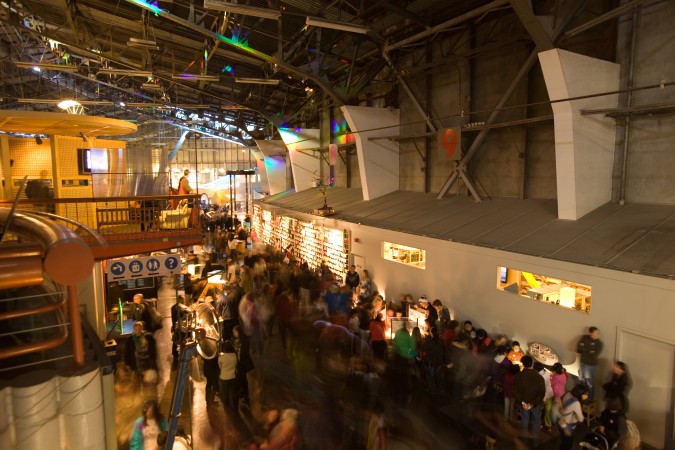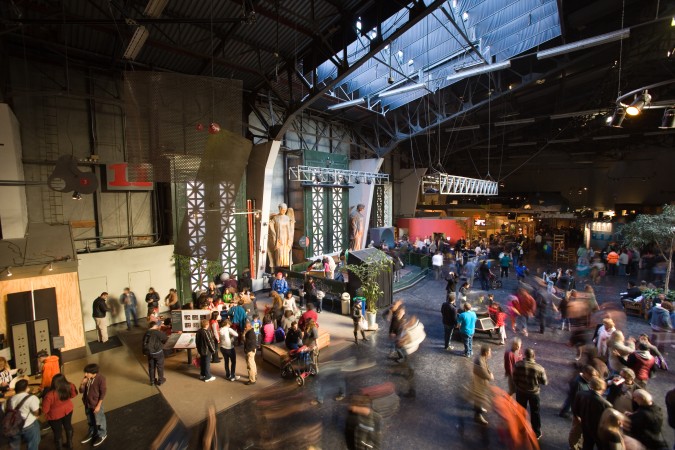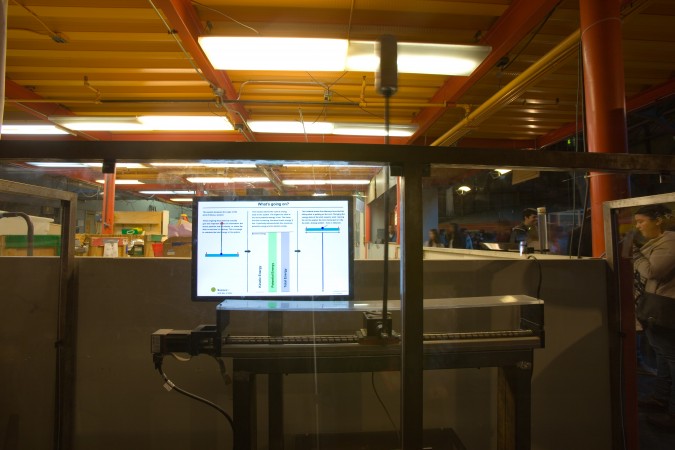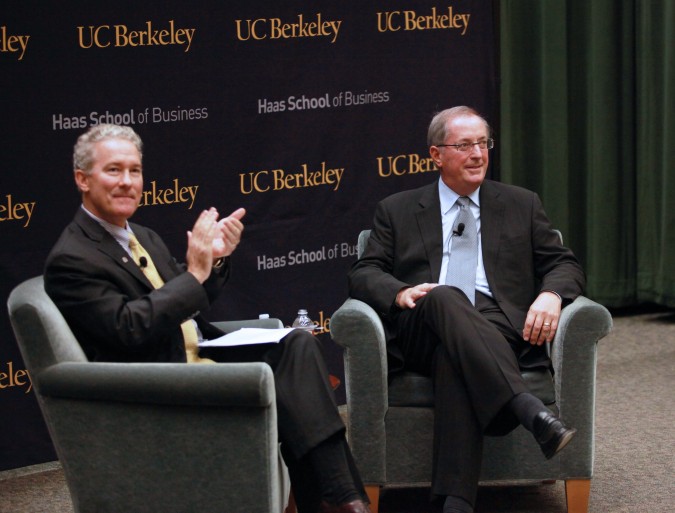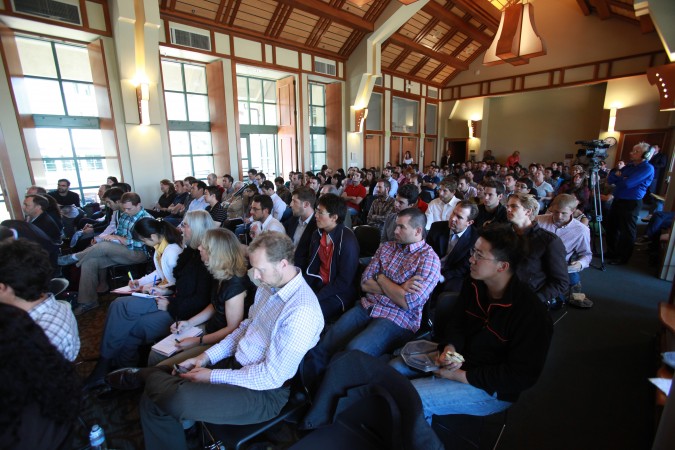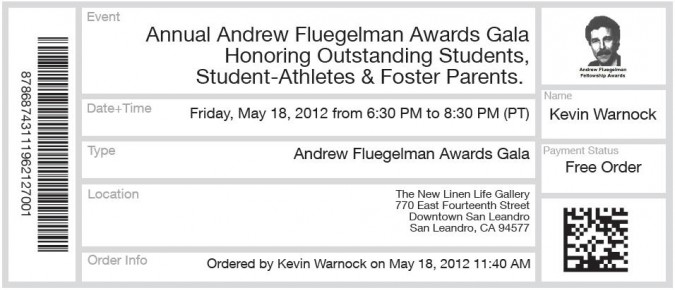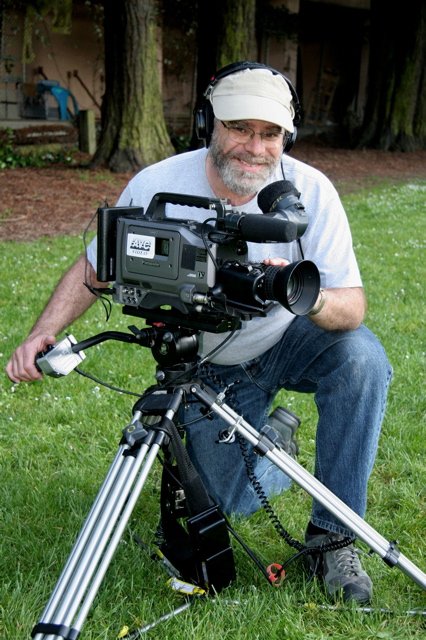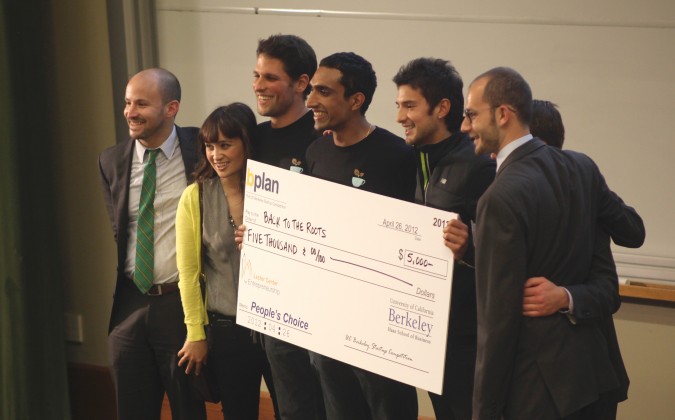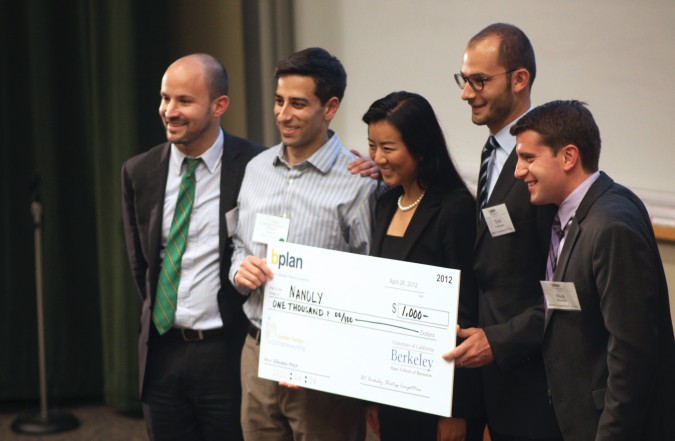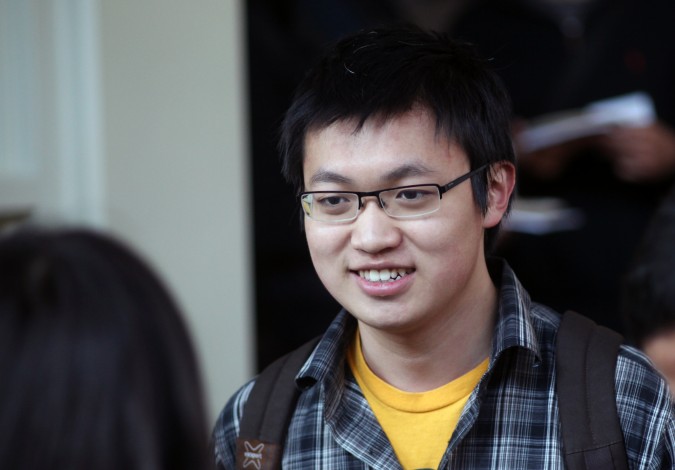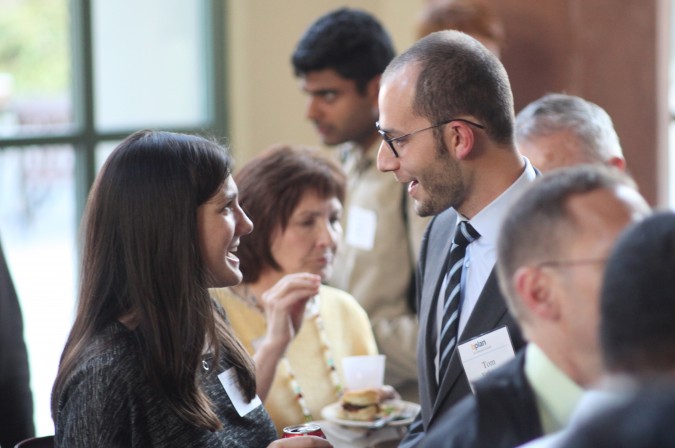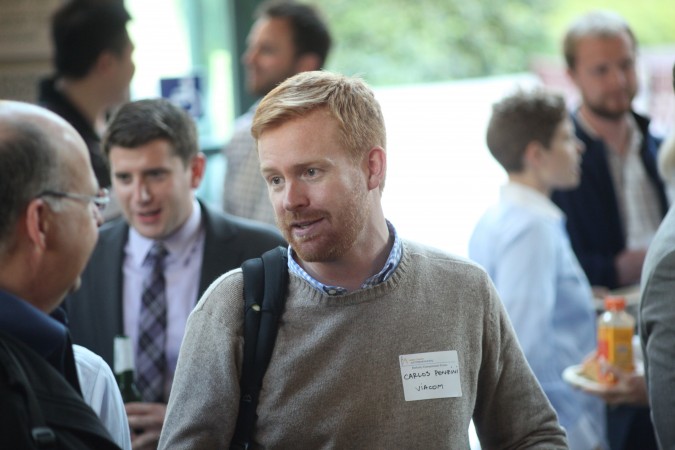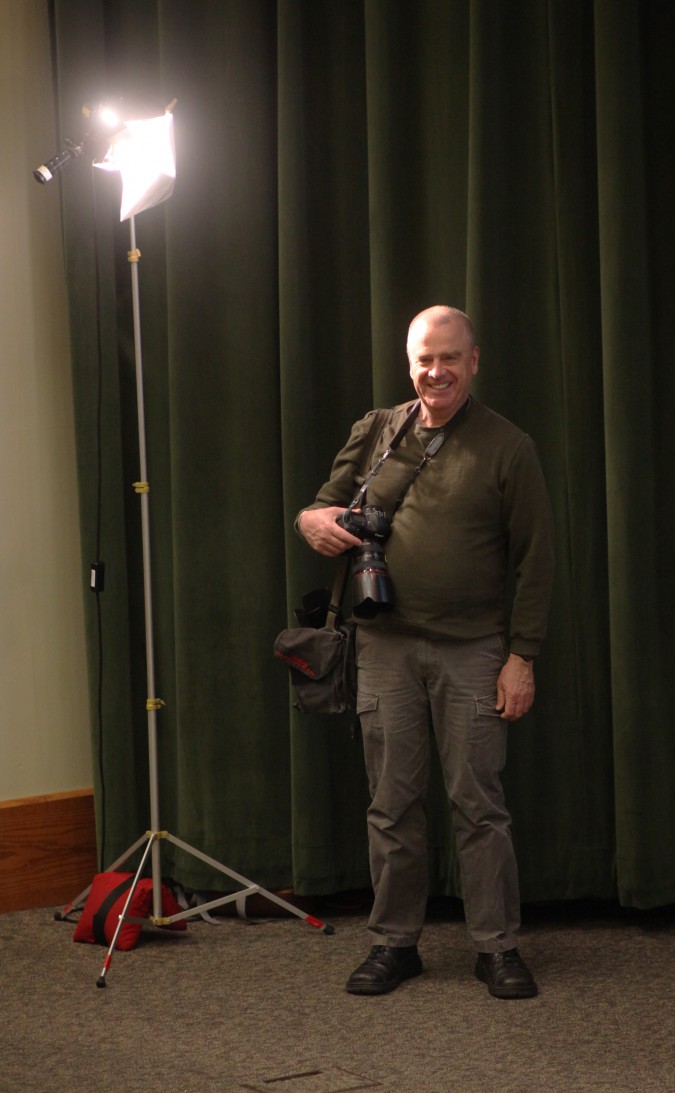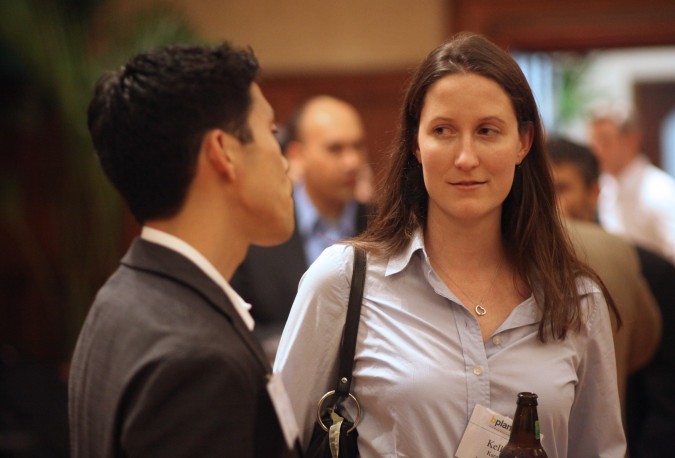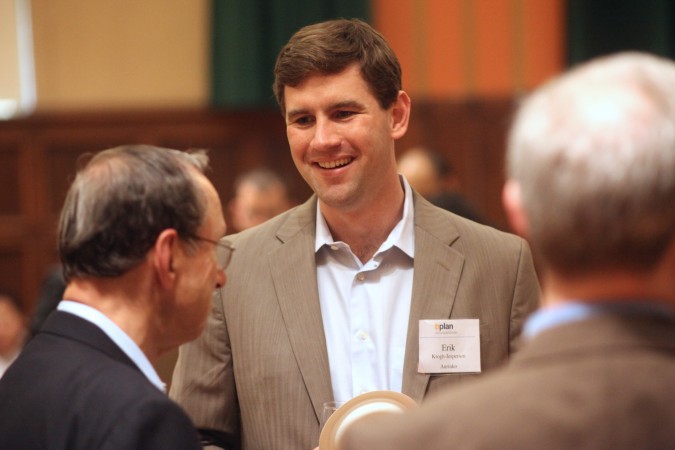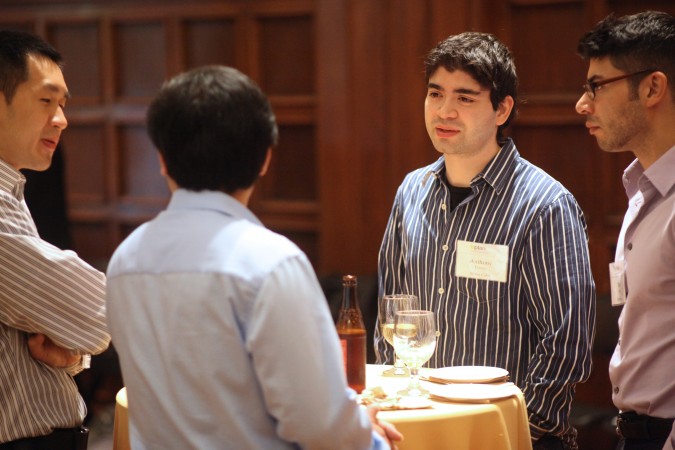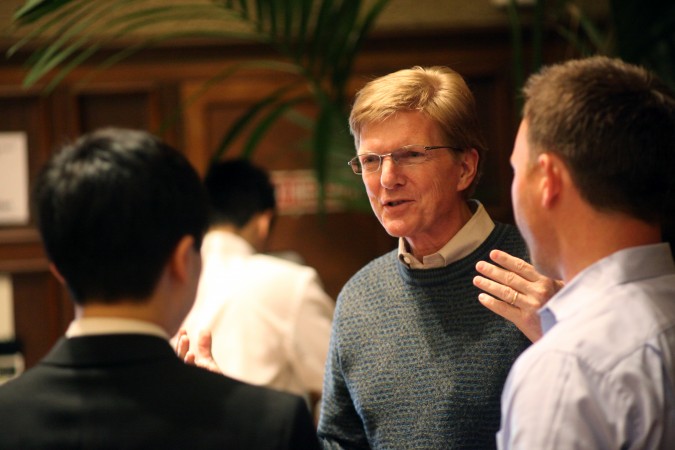Archive for the ‘Education’ Category
First annual Intel Make it Wearable competition November 2, 2014
On Sunday afternoon, November 2, 2014, I had the pleasure of attending the first annual Intel Make it Wearable to identify exciting technology companies making or proposing to make computers that one wears rather than carries or is stationary.
Make it Wearable is an ambitious new competition, and it’s the most polished and exciting competition I have attended. That’s saying something as I have attended dozens of competitions over the years.
The ten finalists come from China, Chile, the United Kingdom, Germany and the United States. The ideas were wonderfully diverse as you’ll soon learn which helped to keep the event lively and full of surprises. Sex appeal for business competitions is desirable because it helps attract the press and future competitors. I saw reporters from Yahoo and CNet at the event, and even reporters from the Middle East.
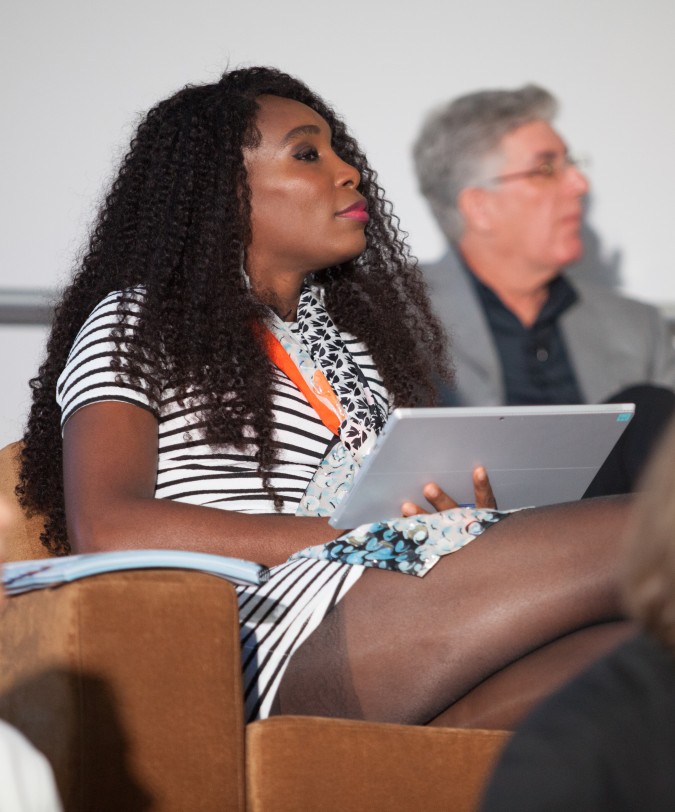
Venus Williams listening to a pitch as a judge for the 2014 Intel Make it Wearable competition on November 2, 2014. Note the Intel chip containing Microsoft Surface Pro tablet computer Williams is holding. The judges voted via these tablets.
Before I jump into the companies, allow me to talk about the event venue, the W Hotel across the street from the Moscone Convention Center in San Francisco, California USA. This was a great choice. The W is very fashionable. It’s not dull and boring like so many big hotels. Intel didn’t just go with a standard W event room though. A designer outfitted the rooms with custom wall textiles that resembled old barn wood and white painted bricks. This theme carried through to the custom printed name tags. There were light sculptures that featured dozens of clear globed incandescent light bulbs dimmed enough you could see the glowing filaments without squinting. These bulbs were dangling down on wires, and the idea was to reference the light bulb over the head to bring up the idea of a fresh new idea being thought up.
There was a disc jockey ever present in the two rooms, though one used her RFID embedded fake fingernails to manipulate a musical track by dipping her fingers in a shallow clear box of water. She got a lot of attention for this, and it was mesmerizing to watch. I learned this was her first gig playing music by playing with water.
The rooms were packed, and the crowd was surprisingly stylish and hip… far, far more hip than the crowds at the business competitions I have attended on college campuses. The only negative is that the event was not open to the public, a big change from previous Intel business competitions I have attended for years in Berkeley, California. I suspect the reason is that this first year was an experiment for Intel, and they wanted to test things out before widening the audience base. I was invited by Intel, a company that has been very kind to me over the years. My last Internet startup was an Intel Capital portfolio company.
My favorite company is Pro Glove, out of Germany. This team won third place and USD $100,000 in the competition.
Pro Glove makes solutions to improve the accuracy and speed of production factory workers. The company says there are 200 million such workers in the world.
The company sells gloves, sensors and software to process the data returned by the globe embedded sensors. Factories apparently for the first time can see exactly what workers are doing with their hands. If a worker skips a production step, the software can spot the mistake and flash a light on the glove to warn the worker to go back and complete the step. The glove analytics software can even tell where the worker is standing in the factory, so if they are walking around needlessly to fetch tools, the manager can spot that an perhaps move the tools closer to the worker to save walking time.
Pro Glove said that for BMW, each second saved on a repetitive task making a car translates into USD $7,500 per year savings for BMW, so having analytics about hand movements of production workers strikes me as a must have. Pro Glove cited various return on investment periods for their different use scenarios. Sometimes the system is predicted to pay for itself in a year, and sometimes in just there months.
I can see Pro Glove gloves being a must have in leading edge factories, and I can see room for lots of follow on products that will have high margin, particularly for the software designed to analyze the glove data. I think a large and enduring business can be built, and that is why I give this team my highest vote.
My second favorite team is Open Bionics, out of the United Kingdom. This team won second place in the competition.
Open Bionics proposes to make low cost three dimensionally printed bionic hands for children. The team proposes a price of just USD $2,000, which apparently is shockingly low compared to current bionic hands, which they said can cost up to $100,000 each.
The Open Bionic model is not as durable or as functional as the models costing 50 times more, but the low cost allows families to fit their handless children with a bionic hand multiple times as needed as they grow up. Apparently insurance won’t pay for a new $100,000 bionic hand each year for a growing child, so handless kids just grow up without handless until they stop growing and can get a fully featured metal bionic hand. Open Bionics was not specific about how current costly models are paid for and how often they are replaced, thus I am reading between the lines a bit here in this paragraph.
The Open Bionic team proposes to keep the cost low by not having patients meet with any medical professionals. Instead, the company will send an Apple iPad brand computer tablet with a 3D scanning attachment to the patient by postal mail. The customer will scan their own arm stump and return the iPad to the company. The company then prints out and assembles a hand that will fit the exact stump dimensions of the patient, and the hand will just show up at the customer’s home by common carrier, to be self installed by the customer.
The hands don’t have a wrist joint, but they can open and close by the wearer just thinking the same thoughts handed people think when they want to open or close their fist. There are electrode sensors that are taped to the forearm of the wearer, and the Open Bionic team had the electrodes on his own arm, and could make the bionic hand open and close just by his thoughts controlling his forearm muscles. It was an impressive demo.
I got to play with one of the bionic hands, and I could feel the hand squeezing my hand when activated by a push button ‘demo’ switch.
Open Bionics has the opportunity to dramatically improve the life of handless children. The price proposed frankly seems too low to keep the company afloat, so I worry about their viability. But the price can be adjusted, and since the team won USD $200,000 in this competition, they have some breathing room to figure out both their technology and the business.
My third favorite team is Nixie. This team won the grand prize in the competition — USD $500,000.
Nixie had the most eye popping video demonstration of their product.
Nixie proposes making a tiny drone helicopter that contains a still and video camera. The drone can fold up and wrap around a person’s wrist. With the flick of the wrist, the drone can be unfolded and then can start up and take flight away from the wearer. Once at a suitable elevation and distance, the camera can face the use and take a picture or start recording. Once done, the drone will fly back to the user and turn off.
Nixie sees itself as a competitor to Go Pro and similar action cameras. Eventually Nixie says they want to compete with normal point and shoot digital cameras.
I held a prototype Nixie drone in my hand, and it is cute. However, it looks impossibly fragile and totally unsuited to wearing while rock climbing, the stated first market Nixie envisions. I can see the drone simply falling off the wrist and falling on someones head below.
But I am happy Nixie won first place in this competition. The idea I think will wow many observers, and it will help brand the competition as one where really cool consumer products can be born and launched. That’s good for Intel and good for the competition.
But I think Nixie won by making the drone wearable as a way to be eligible to compete in this competition. In the absence of the competition, I think the product would have taken a different form. If I were rock climbing, I would want the drone in a protected case that I could easily open and access when the time was right for taking pictures.
Nixie is likely to be costly to start. I can see it costing USD $1,000 to early rock climbing adopters. I think they will find customers even at this price.
I don’t think there are strings attached to the Intel half million dollar prize, so I think that Nixie is welcome to ditch the wearable aspect in favor of practicality. I encourage them to go that route, even though it may secretly irritate Intel.
I admire Nixie for getting a non dilutive $500K to pursue their photography drone. This kind of thinking is the hallmark of successful entrepreneurs — tailoring an offering for the market at hand. Intel was the customer, and Nixie gave Intel a product it asked for. And Intel will be proud of Nixie even if they just become a successful photography drone company.
I can also imagine ways to make a Nixie both wearable and very unlikely to get damaged during arduous climbing. Just put it into a head mounted hard case inside a custom helmet. When the time comes, the helmet wearer could command the helmet to open and for the drone to take off from there. This could even be voice activated via a helmet mounted microphone.
Sadly, I don’t have time right now to finish this post. My grandmother is turning 103 years old December 12, 2014, and I have a project I have to finish by then as I promised her I would take it to show her. I have already spent three days on this Make it Wearable competition, and I need to get back to my regular life. I have a lot more pictures to post, and I want to tell you about the seven other companies, which also are very interesting.
SFJAZZ Center opening evening, San Francisco, California USA, January 21, 2013
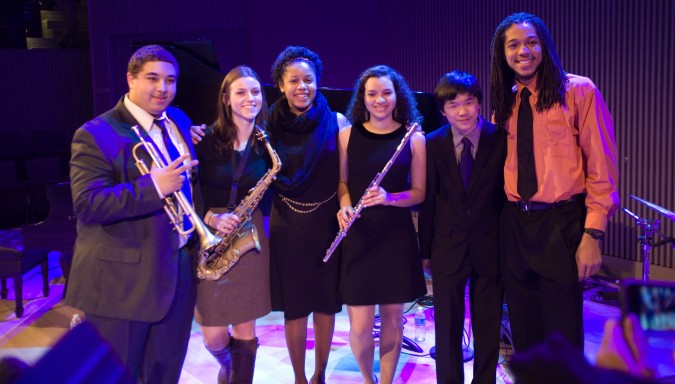
SFJAZZ High School All-Stars at opening night for SFJAZZ Center, San Francisco, California, January 21, 2013. Photograph by Kevin Warnock. Left to right: Tracy Fitzsimmons, Jill Ryan, Aneesa Al-Musawwir, Elena Pinderhughes, Matt Wong and Malachi Whitson.
This evening, January 21, 2013, I had the great pleasure to tour the brand new SFJAZZ Center, at 201 Franklin Street in San Francisco, California USA.

SFJAZZ Center exterior photographed on opening night, January 21, 2013, San Francisco, California USA. Photograph by Kevin Warnock.
The SFJAZZ Center is an ambitious center to advance jazz music.
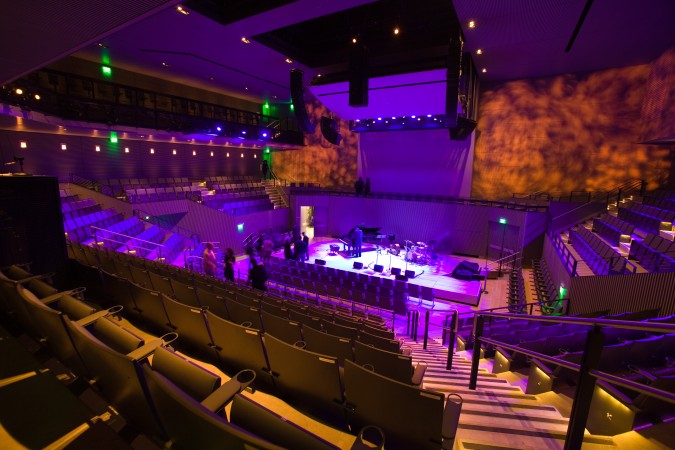
SFJAZZ Center Robert N. Miner Auditorium on opening night, under theatrical lighting, January 21, 2013, San Francisco, California USA. Photograph by Kevin Warnock.
I think the corner of Franklin Street and Fell Street is an outstanding location for the Center — it’s in the trendy and safe Hayes Valley neighborhood, and it’s just two blocks from the Van Ness MUNI station and Market Street.
There was a ribbon cutting ceremony in the morning, which I missed.

SFJAZZ Center second floor reception area on opening night, January 21, 2013. Photograph by Kevin Warnock.
I went to one of the official tours, in the evening. Attendees got to roam around the facility and admire the building, constructed in 2011 and 2012 to be the new dedicated home for SFJAZZ.
The formal part of the evening featured prepared remarks by Randall Kline, the Executive Artistic Director and Founder of SFJAZZ.
Rebeca Mauleón, the Director of Education, also spoke.
The SFJAZZ High School All-Stars performed in the large music hall, named the Robert N. Miner Auditorium, which features steeply set seats designed to allow the musicians to see the faces of the audience members. This Auditorium also features a glass wall that looks out onto the busy street, which will drum up interest in the performances because passersby will be able to catch a glimpse for free as they walk or drive past. I’ve always thought it is good marketing for martial arts studios and dance studios to have large glass windows at street level. SFJAZZ Center is taking a page out of their public relations book, and I predict good things will happen as a result of doing so.
I was exceptionally impressed with the High School All-Stars. I introduced myself to the members and invited them to read my blog.
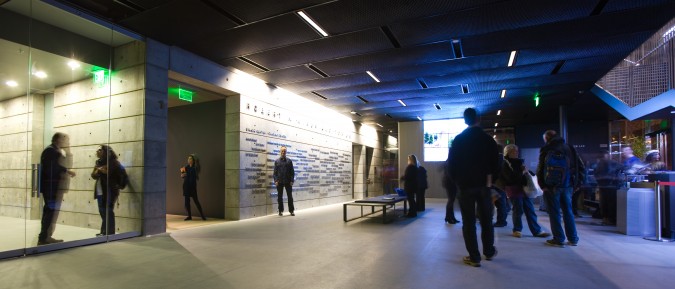
SFJAZZ Center, ground floor reception area, on opening night, January 21, 2013. Photographer and blogger Kevin Warnock is standing by the donor names on the wall.
I was given a lushly produced magazine/program for SFJAZZ during the tour this evening. SFJAZZ Founder Randall Kline had this to say, on page 7:
Welcome to the first season
After 30 years of presenting music in a variety of rented venues throughout the Bay, it is with great joy we begin our first season in our new home, the SFJAZZ Center. It is the first freestanding building for jazz in the country — designed, from concept to concert hall, to create an enhanced setting for experiencing what the esteemed jazz write Whitney Balliett calls “the sound of surprise.”
The SFJAZZ Center is home for all that we do: concerts, education programs for adults and youth, our award-winning SFJAZZ High School All-Star Ensembles, the world-renowned SFJAZZ Collective, and the new SFJAZZ Monday Night Community Band.
Over our three decades, SFJAZZ has grown to become a vital part of the cultural fabric of San Francisco. And in the broader context of the jazz, we have been recognized as one of the top presenters in the world — helping to place San Francisco, with its rich jazz history, among the vanguard of cities where this American-born art form can be best heard.
Kline continued his remarks — I have not typed all of them here — and concluded with:
Jazz has a home in San Francisco. The first season begins. See you at the Center!
Sincerely,
Randall Kline
Executive Artistic Director and Founder
The new Center shows a lot of promise. I am intrigued, so I plan to return soon to the Center to see a show.
I took the pictures that accompany this post with my Canon 5D Mark II camera. I uploaded these images at full resolution of 21 megapixels. Click on them to see the full size versions.
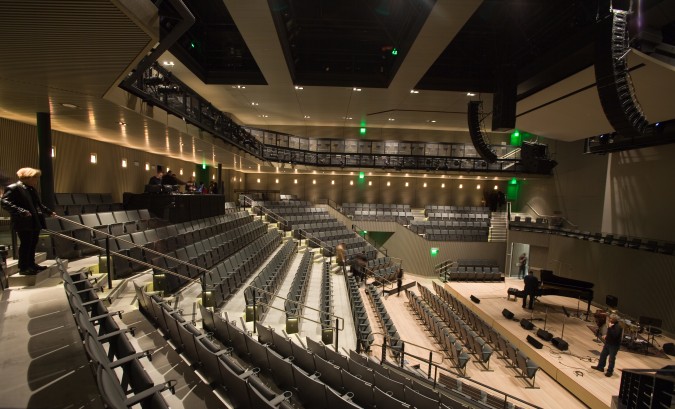
SFJAZZ Center Robert N. Miner Auditorium in neutral, bright light on opening night, January 21, 2013. Photograph by Kevin Warnock.
Today was a busy day in the United States of America.
- The country celebrated the birthday of Martin Luther King, Jr. with a federal holiday.
- It was inauguration day for US President Barack Obama, who began his second term yesterday.
- The SFJAZZ Center officially opened its doors.
Outstanding.
[Edit on January 23, 2013 — I added two names to the caption of the group photo of the All-Stars, above, once I got the correct spellings.]
Video January 2, 2013 of the final minutes of The Exploratorium science museum at The Palace of Fine Arts in San Francisco, California USA

The Palace of Fine Arts shortly after sunset on January 2, 2013, the final day the Exploratorium was open to the public.
Two days ago, on Wednesday, January 2, 2013, I captured high definition video of the official public closing of The Exploratorium science museum at 3601 Lyon Street at The Palace of Fine Arts in San Francisco, California USA. Today I present that video, without editing other than concatenating the files together in the order I shot them.
This blog post complements the post I wrote yesterday, The final day at The Exploratorium science museum at The Palace of Fine Arts in San Francisco, California – January 2, 2013, where I presented 24 of the still photographs I took at the closing, including the image above of the Palace of Fine Arts after magic hour but before dark. It takes time to compress and upload video, and the video I present today was not done yesterday, thus this second post.
The final day at The Exploratorium science museum at The Palace of Fine Arts in San Francisco, California – January 2, 2013
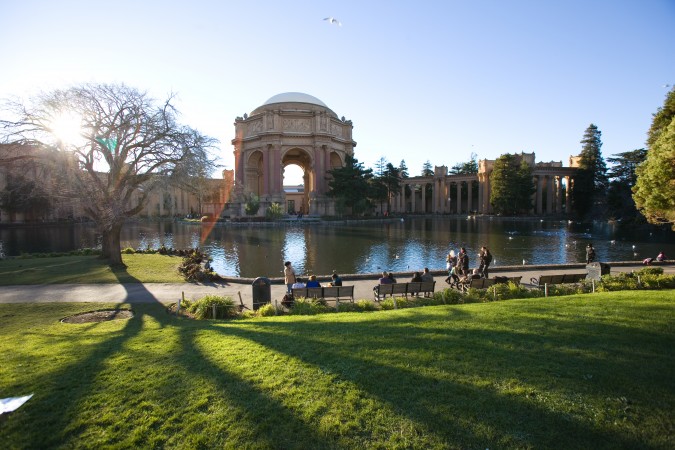
Palace of Fine Arts about an hour before sunset on January 2, 2013, the final day of operation of The Exploratorium science museum at that location.
Earlier today I took an emotional trip down memory lane by photographing the world famous Exploratorium science museum during its final hour at its building at The Palace of Fine Arts in San Francisco, California USA. On Friday, April 12, 2013, the Exploratorium opens at its new location at Pier 15, on the historic waterfront north of Market Street and near the Ferry Building in San Francisco. Pier 15 is served by historic restored street cars that stop in front, so I predict that many more people will visit, since the original location is rather difficult to access, and parking in particular is a nightmare.
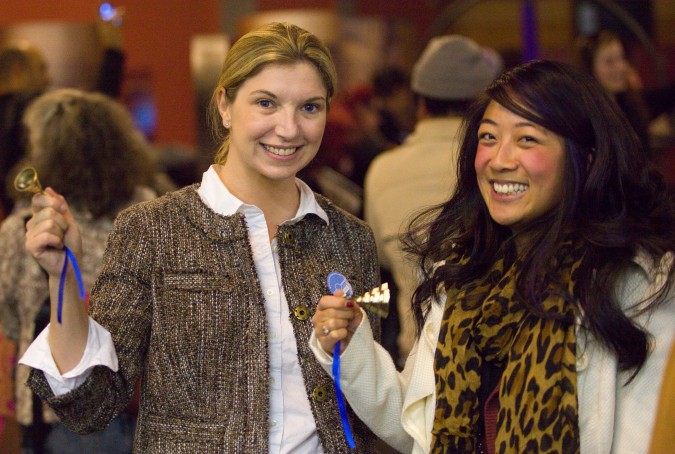
Bell ringers smile as they celebrate the start of a new chapter for the Exploratorium, January 2, 2013
If invited by the Exploratorium staff, for example after they discover this post, I will cover the opening event on this blog, and I will photograph it with the same quality technique I used for the photographs that accompany this post. If not invited, I will wait for a free admission day to visit.
I used my Canon 5D Mark II camera for these pictures. I uploaded the pictures at full camera resolution of 21 megapixels. Click on them to see them at full size. I used a tripod for many of the shots, and since it’s so dark inside the Exploratorium, many of the pictures were made with time exposures of up to 8 seconds. That accounts for the blurred people in some of the shots. I like that the blurring suggests lots of busy activity at the museum, which is definitely true. The tripod shots were taken at ISO 100, so the image quality is outstanding. The handheld shots were taken at ISO settings as high as 6,400, and the quality suffers. I should have brought a flash so that I could have taken more photographs of visitors experiencing the exhibits.
I love and admire The Exploratorium museum above all others. The Exploratorium teaches visitors about the world we all live in, and it does it in such an engaging and fun way that visitors keep coming back, over decades. The exterior wall of the large gift shop was covered with sweet notes from visitors, and these note cards were grouped by decade. Even the 1970s section had over 100 cards on it.
The Exploratorium opened in 1969.
The Exploratorium has exhibits that seed the imagination, so this museum helps human kind progress. I think The Exploratorium is more effective at seeding the imagination than even the traditional great museums of the world such as The Louvre.
I almost missed this special day, and had it not been for the website Funcheap San Francisco which lists free or inexpensive ways to have fun in my favorite city. I subscribe to the site’s Facebook page, and a status update to that page alerted me to the final day I am covering here.
Here below is a sequence of photographs that give you a tour of this large museum space, starting and the front, then moving to the upper deck level, and finally showing the back of the museum from the deck.

View from shortly past the front entrance to the Palace of Fine Arts Exploratorium, January 2, 2013, minutes before closing time.
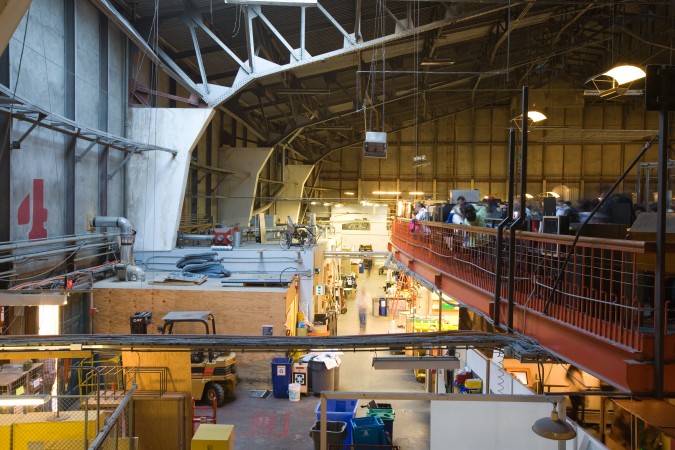
The workshop where the exhibits are built, January 2, 2013. Note that it appears to me that many of the big shop tools have already been removed.
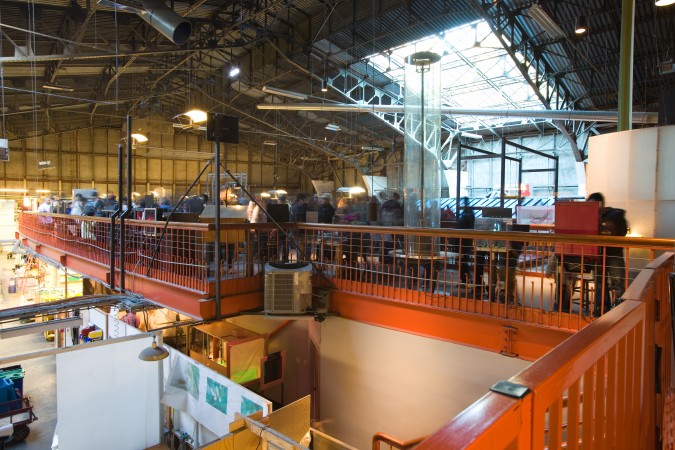
The upper deck that overlooks the workshop area at the Palace of Fine Arts Exploratorium, January 2, 2013.
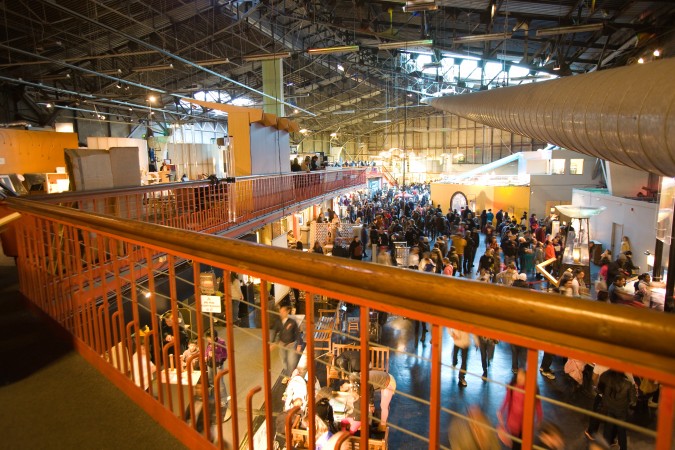
Looking toward the front entrance to the Exploratorium during the final hour of operation at The Palace of Fine Arts, January 2, 2013. Look at the echo chamber pipe in the upper right of the frame.
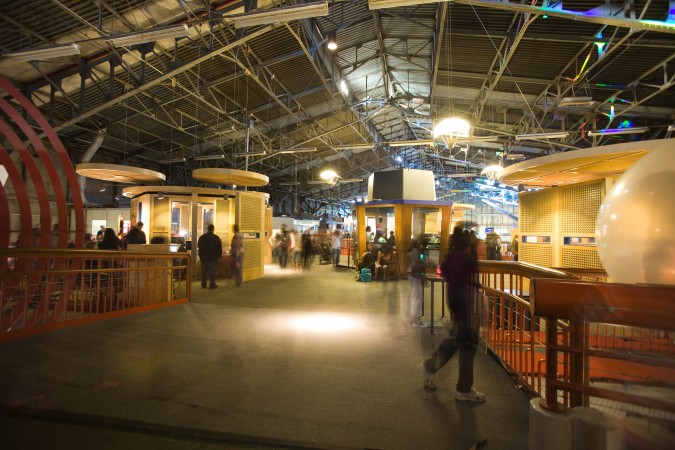
A 6 second long exposure of the upper deck at The Exploratorium on its final day at The Palace of Fine Arts, January 2, 2013
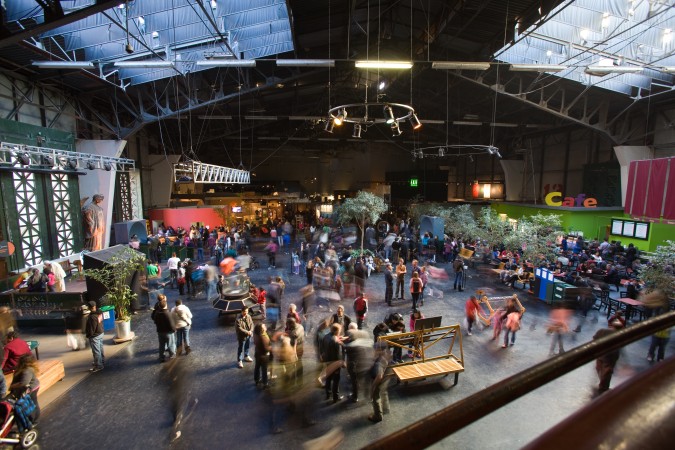
From the upper deck looking toward the back of The Exploratorium at The Palace of Fine Arts, January 2, 2013. Notice how most of the illumination is from the enormous skylights. It's always been dark inside, even when I was in high school. It's a good thing I brought my tripod to allow long time exposures.
Now I will show you some of the exhibits. Note that no admission was charged today, so there were more visitors than normal. I only had one hour to take still pictures and video, so I was rushed.
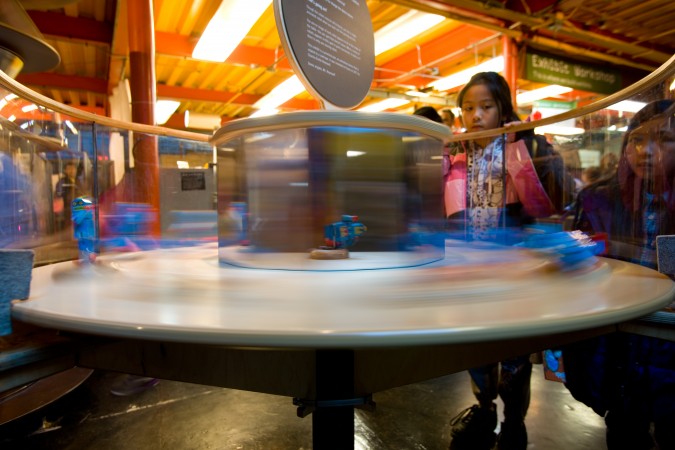
A spinning exhibit with mirrors and toy action figures. When spun, a viewer looking into the mirrors sees an animation of all the figures.
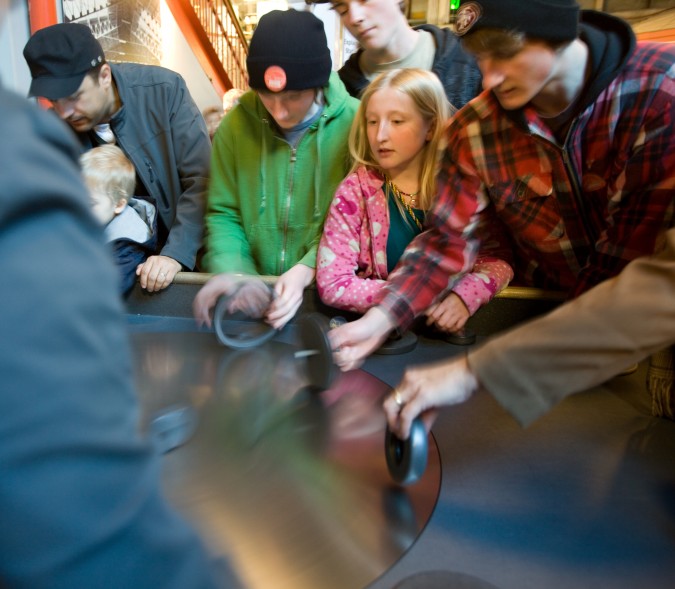
The round disk in the table surface is rotating. Visitors try to place metal wheels onto the surface of the quickly rotating disk. If successful, the wheels roll mostly in place relative to the visitor. I remember this exhibit from my childhood.
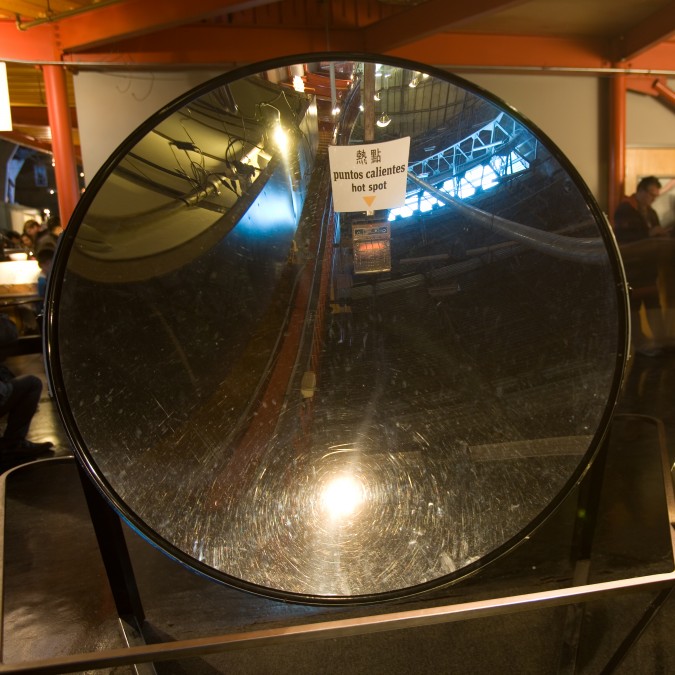
Large parabolic shaped mirror demonstrates that light and heat can be focused to a point. Note electric space heater pictured in the center of the mirror.

Colorful exhibit at The Exploratorium, January 2, 2013. Sadly, I was so rushed that I didn't learn what is being taught here.
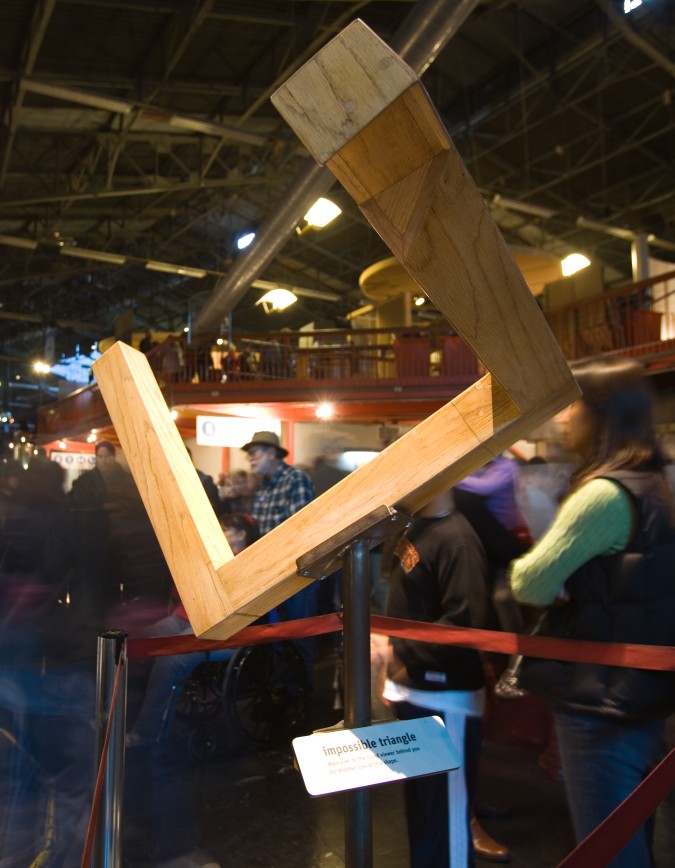
I remember this exhibit from when I was in high school. From a specific vantage point to the right, this looks like a solid triangle of wood. From this angle, it's quite a different shape. Memorable.

I remember this water vortex exhibit from when I was in high school. This plastic cylinder is about a meter across and 2 meters tall... impressive.
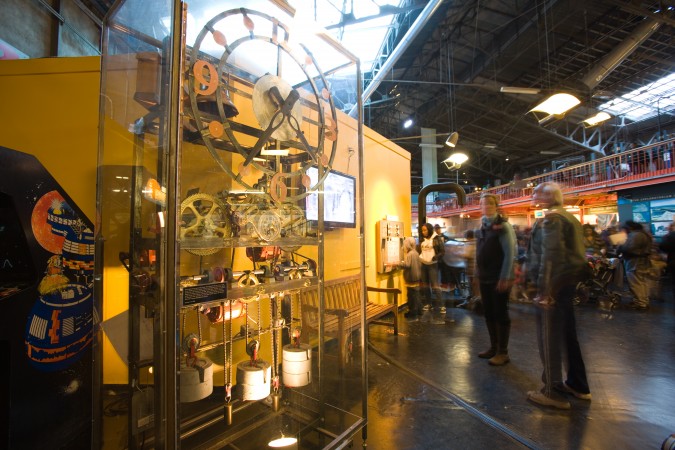
Large mechanical clock powered by energy stored in lifted concrete weights. This shot was taken at 4:35pm, 25 minutes before the Palace of Fine Arts Exploratorium closed forever on January 2, 2013.
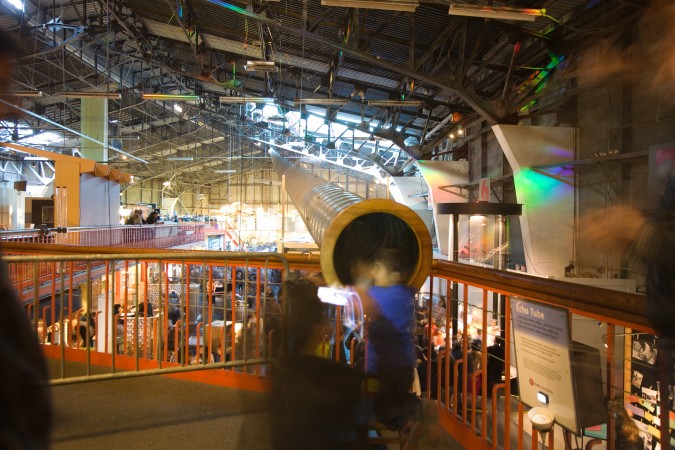
A child clapping into a long echo chamber tube, and listening to hear the sound of his clapping race to the end of the tube and back
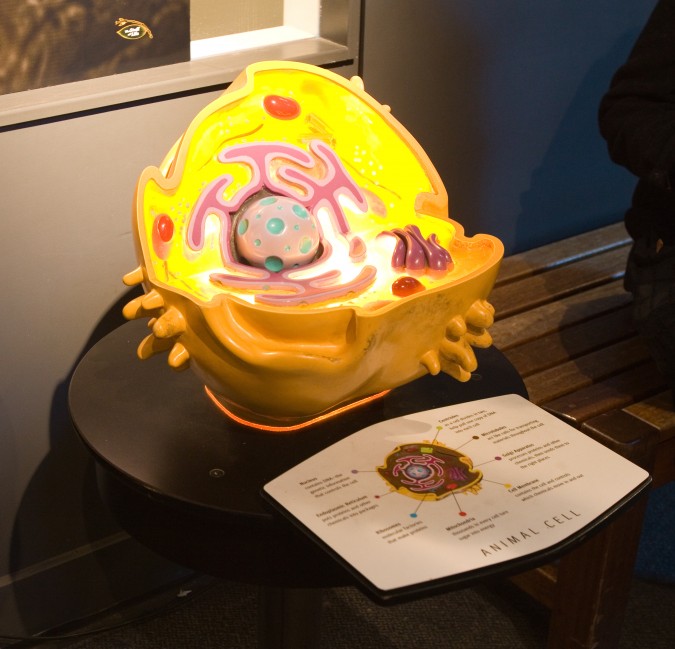
A model of an animal cell at The Exploratorium science museum at The Palace of Fine Arts in San Francisco, California USA, January 2, 2013
As I was leaving, I picked up a free poster advertising the new location for the museum, which will be Pier 15 on the San Francisco waterfront, downtown, near the Ferry Building.
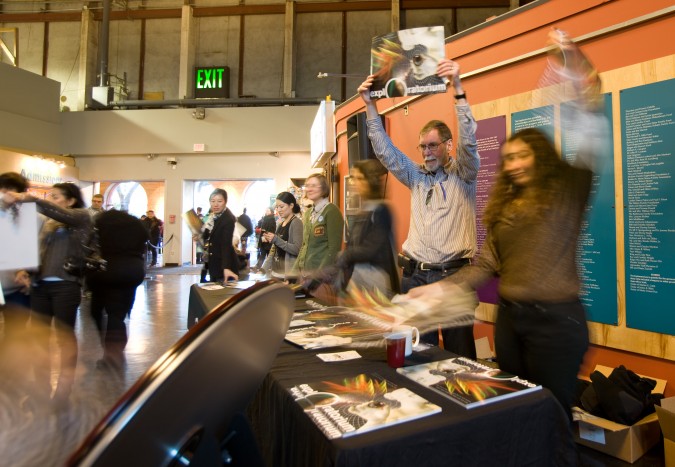
Staff members handing out free promotional posters for the new Exploratorium that will open later this year near the Ferry Building in downtown San Francisco. Picture taken January 2, 2013.
After the gates were closed, there was a private party, with speakers thanking those assembled.

Guests at private party after the closing of The Exploratorium on January 2, 2013 listen to remarks from various speakers over the public address system.
I set up my tripod outside the front door and posed for a self portrait to memorialize this memorable day.
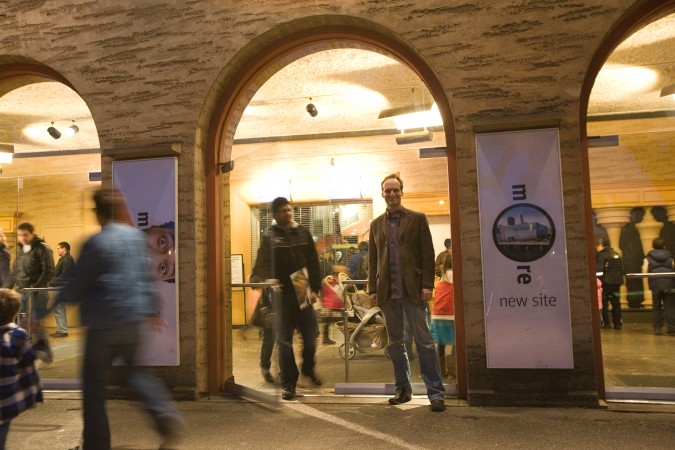
Kevin Warnock, right, stands in front of The Exploratorium at The Palace of Fine Arts in San Francisco on its final day, January 2, 2013. Photograph taken via self timer.
On my way back to my car, which I parked many blocks away, I set up my tripod one last time to take this ‘magic hour’ photograph of The Palace of Fine Arts.

The Palace of Fine Arts shortly after sunset on January 2, 2013, the final day the Exploratorium was open to the public.
Note that the Exploratorium posted a sign at the entrance warning visitors that pictures and video would be captured by many people today, and that some of the material would be published.
I will miss this original location. It’s industrial and gritty and feels authentic. Outside by the adjoining Palace of Fine Arts, the location is truly beautiful. I fear that the new location will be too new, sparkly and flashy, and that the glitz will remove the charm that permeates the original.
Intel CEO Paul Otellini is interviewed by Haas School of Business Dean Rich Lyons, October 3, 2012 at University of California Berkeley

Intel CEO Paul Otellini at University of California Berkeley, October 3, 2012. Photograph by Kevin Warnock.
Yesterday afternoon, Wednesday, October 3, 2012, I attended the Dean’s Speaker Series at the Haas School of Business at the University of California Berkeley, in Berkeley, California USA.
Dean Richard Lyons interviewed Paul Otellini, the Chief Executive Officer of Intel Corporation. The question and answer session was held in the Anderson Auditorium, a venue I am very familiar with because it’s the same hall where the Berkeley Entrepreneurs Forum is usually held. I have attended the Forums for 20 years.
The interview was captured by a professional videographer, and the video will be soon made public on the Haas website page for the Speaker Series.
I have highlighted my favorite parts of Otellini’s remarks in my comments that follow.

Haas School of Business student asks Intel CEO Paul Otellini a question October 3, 2012 at University of California Berkeley
Otellini completed his undergraduate studies at University of San Francisco, and received his Master of Business Administration from the Haas School of Business, though at the time it was named the Berkeley Business School. Otellini got a job at Intel in 1974 with his freshly minted MBA degree. Even though Otellini was a finance specialist, his first job at Intel was to program a Digital Equipment Corporation PDP-10 minicomputer to perform cost analysis. This must have been an intense introduction to Intel for an MBA because mini-computers were not easy to program. I programmed a Digital Equipment Corporation VAX minicomputer in 1990, and it was difficult then, so I can only imagine how much more pesky and complicated it was to work 16 years earlier on the ancestor to the VAX.
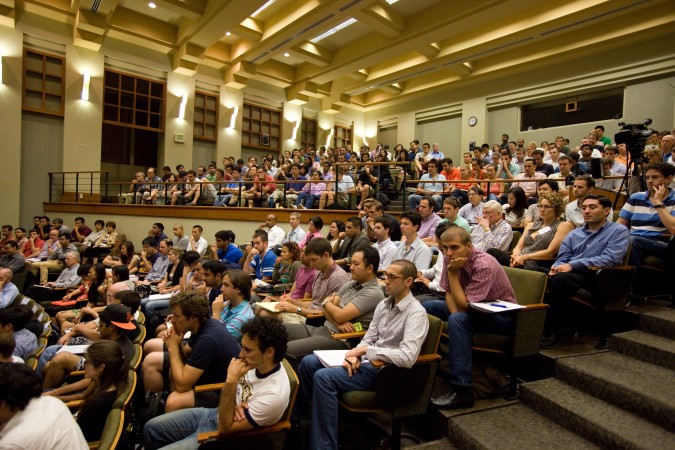
Audience watches Rich Lyons interview Intel CEO Paul Otellini, October 3, 2012 at University of California Berkeley, in Berkeley, California USA
When Otellini became CEO in 2005 he assessed that Intel was not organized correctly for where he saw the market heading. At the time, Intel had 105,000 employees. Otellini eliminated 25,000 jobs. The company is today back up to 103,000 employees. His advisers in 2005 were asking why he wanted to go into ‘the phone business’ when Intel was making money hand over fist at the time. Otelllini said he had many sleepless nights when he was contemplating letting 25,000 people go. He said he will never feel good about that, but he is grateful that he made the change well before the world financial collapse of 2008, so all the people let go were able to find jobs quickly.
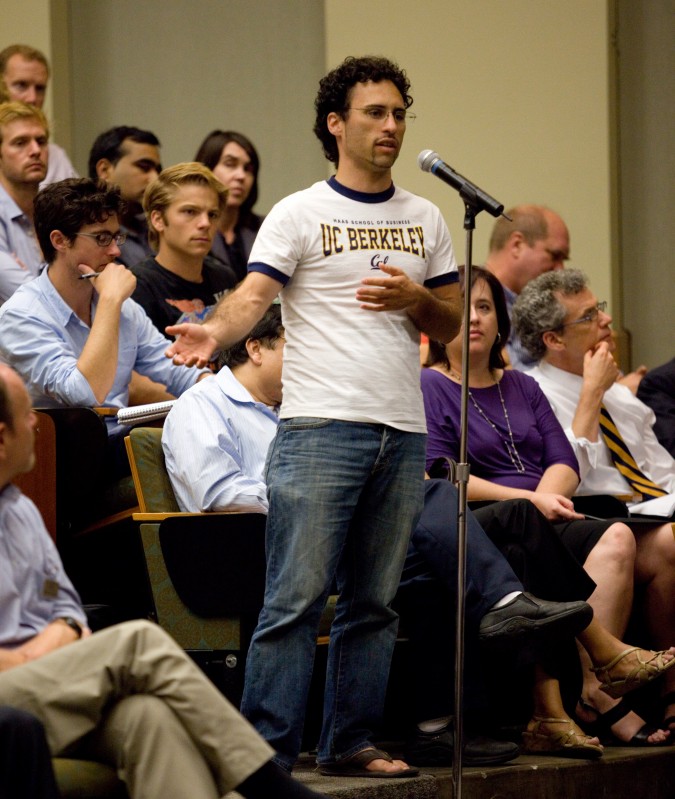
Second year Haas student Michael Vladimer asks Intel CEO Paul Otellini a question, October 3, 2012 at University of California Berkeley. To the right of the student, seated: Jill Erbland and Andre Marquis.
I was surprised to learn that Intel is the world’s 4th largest software company in the world based on the number of computer programmers that it employs.
Otellini advised to get work experience in different geographic locations prior to starting a family.
Otellini said its chips are manufactured in three dimensions, which was forced upon it by the laws of physics, which prevented circuits from being made much smaller. To keep making more capable chips, transistors had to be stacked as well as placed side by side. This technology took Intel 10 years to perfect, with thousands of PhD holders working on the effort.
I wonder if they considered adding a ‘Now in 3D!’ tagline to their famous ‘Intel Inside’ stickers.
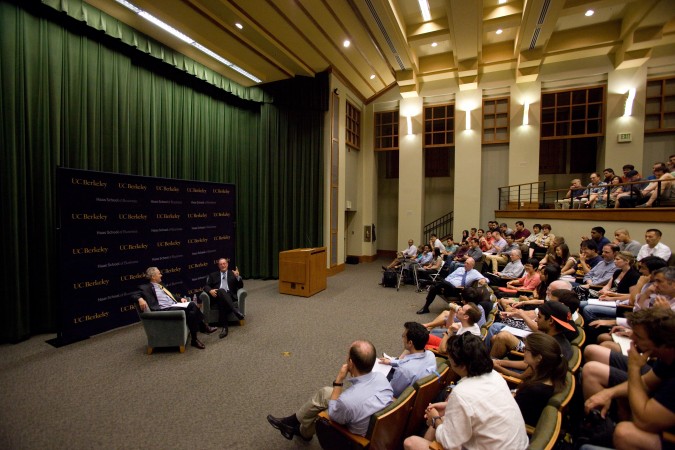
Audience watches Rich Lyons interview Intel CEO Paul Otellini, October 3, 2012 at University of California Berkeley
Otellini emphasized the high risks inherent in running Intel.
To illustrate, when Intel breaks ground on a new chip fabricating factory:
- the technology hasn’t been developed yet
- the products haven’t been designed yet
- the markets for the products don’t exist yet
These factories take 3 1/2 years to build and cost USD $5,500,000,000 each, and Intel starts construction on two or three of these per year.
That sounds like a great definition of high risk to me.
Intel makes hardware reference designs that it provides to its customers so that they can get products to market more rapidly. Otellini said personal computer makers don’t spend that much on industrial design, so they like and need Intel to provide these turn key designs they can modify to make them unique.
Otellini had a mentor at Berkeley while he was a student in the early 1970s. That mentor worked at Bank of America, and tried to get Otellini to join that bank. Several years after Otellini had joined Intel, his mentor confided that Otellini had chosen the right company.
Intel has put in place a system where they can identify the source of so-called conflict minerals. They can also track them, and Otellini said that Intel is likely to be able to say by January 2013 that Intel has built the world’s first ‘conflict mineral free microprocessor’.
Otellini said he had spoken in the morning with Robert Hormats, Under Secretary for Economic, Energy and Agricultural Affairs at the Department of State, who he said is very interested in [removing] conflict minerals from products. The Department of State, according to Otellini, wants to make Intel’s conflict mineral tracking system a so-called ‘best known method’ for the [semiconductor] industry.
Otellini said it recycles the chemicals used in its plants, and plans to recycle the water it uses to such a complete degree that its factories will be able to reuse the water they consume over and over, without needing to return it to the underground aquifers, like they do today.
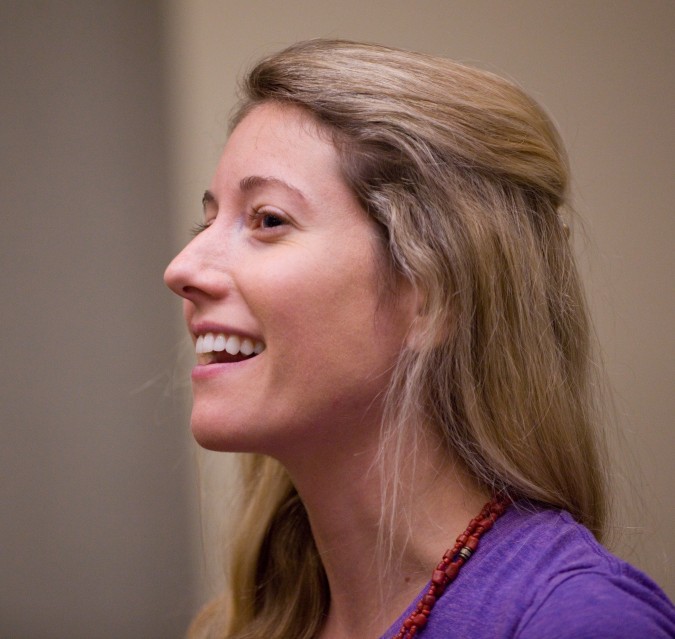
Audience member at Dean's Speaker Series with Paul Otellini at Haas School of Business, October 3, 2012.
Otellini spoke about manufacturing competitiveness generally in the United States, something he is qualified to speak about because he advises United States President Barack Obama about competitiveness.
He said many of the motivating factors that have led to outsourcing are disappearing. He said that it costs more for Intel to hire 1st and 2nd level technical managers in China now than it does in Santa Clara, California USA. For engineers with 3 or 4 years of experience, the costs to hire them are now the same in the US as they are in China and India.
Otellini said that the United States could improve its position by lowering its corporate tax rate [to a level consistent with the rate in competitive economies]. He suggested the US streamline its permitting procedures for building new factories. He suggested that job training be improved to provide a skilled workforce to work in the new factories. He pointed out that currency and political risks are low in the US, and stated there is no risk of a company’s factory being expropriated by the US government. In other countries, governments sometimes do take over privately owned factories.

Paul Otellini speaks with Arthur Gensler at University of California Berkeley, October 3, 2012. Photograph by Kevin Warnock.
There were some famous guests in the audience.
Perhaps the most famous attendee was Arthur Gensler, the founder of M. Arthur Gensler Jr. & Associates, Inc. but commonly referred to as simply Gensler. I have been aware of this global architecture, planning, design and consulting firm since I was 23 years old at my first job out of college, at Newell Color Laboratory at 630 Third Street in San Francisco, California USA, since closed. Gensler was an important client. I suspect Gensler may be helping to design the new building Dean Lyons is being planned for the Haas School of Business campus.

Arthur Gensler speaking with Paul Otellini, October 3, 2012 at Haas School of Business at University of California Berkeley
After the interview, Lyons pointed out Mr. Gensler to me — without his helpful comment, I would not have been able to write this acknowledgment of his visit. Gensler is a big deal — they employ 3,500 people in 42 locations. They count all 10 of the Fortune 500 top 10 companies as clients.
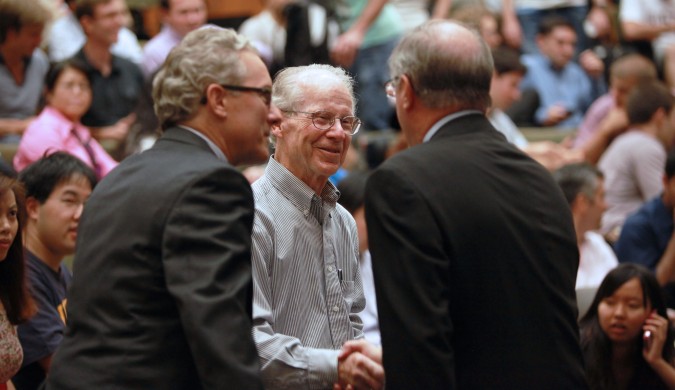
Haas School of Business Dean Rich Lyons, left, watches Haas Professor Emeritus and Nobel Prize winner Oliver Williamson shake hands with Intel CEO Paul Otellini at Haas School of Business at University of California Berkeley, October 3, 2012. Photograph by Kevin Warnock.
Perhaps the second most famous attendee was Oliver Williamson. Williamson is Professor Emeritus at the Haas School of Business. In 2009 Williamson won the Nobel Prize for Economics. I saw Williamson speak in 2009 at the Haas Gala, the annual party the school throws each November. I blogged about that gala and wrote about Williamson, who spoke at the event. I took a picture of Williamson shaking hands with Otellini, shown here.
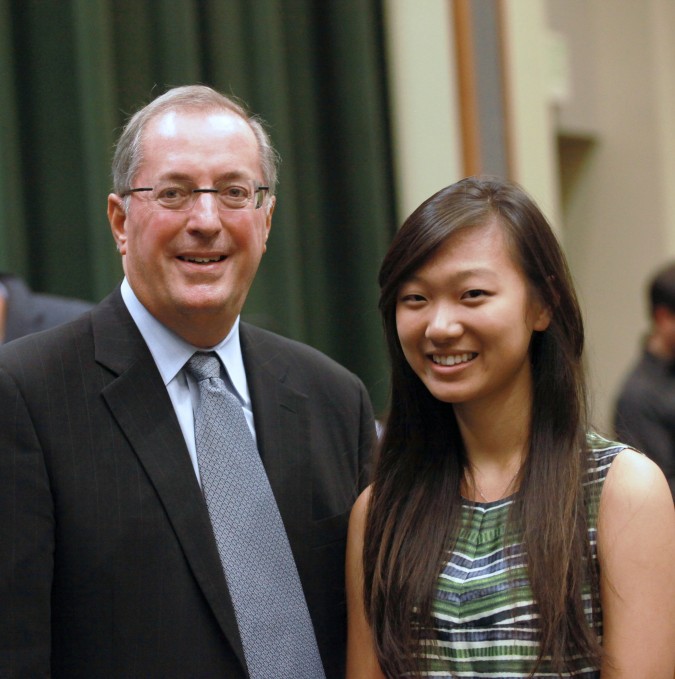
Intel CEO Paul Otellini with University of California Berkeley student Tammie Chen. Photograph by Kevin Warnock, October 3, 2012.
This last photograph of Mr. Otellini with Berkeley undergrad student Tammie Chen has an interesting story behind it.
I met Chen when she was an organizer for the 2011 Made for China Startup Pitch Competition. I was a judge for that competition. After that event, we became friends on Facebook, and she posted that she was going to be attending the Dean’s Speaker Series that is the subject of this blog post. I commented that I would be there as well, blogging. She asked me if I could take a picture of her with Otellini. I said I would. I walked up to him and asked him if I could introduce Chen to him and take a picture of him with her, and he readily agreed. They had a nice chat for a minute, and then they posed for this picture. Chen is a huge fan of Intel, and has visited their headquarters. She has a lot of friends that work at Intel.
I was surprised that no students approached Otellini to introduce themselves. This is the same behavior I saw at my first Dean’s Speaker Series event, in September 2012, when Lyons interviewed Randall Stephenson, the CEO of AT&T. There were students standing about 10 feet away from Otellini, in a large circle, but not a single student walked into the empty space to say hello. That made it easy for me to say hello to Mr. Otellini, who I have met and spoken with before, in 2008, at the Intel Capital CEO Summit [renamed the Intel Capital Global Summit] in San Francisco.
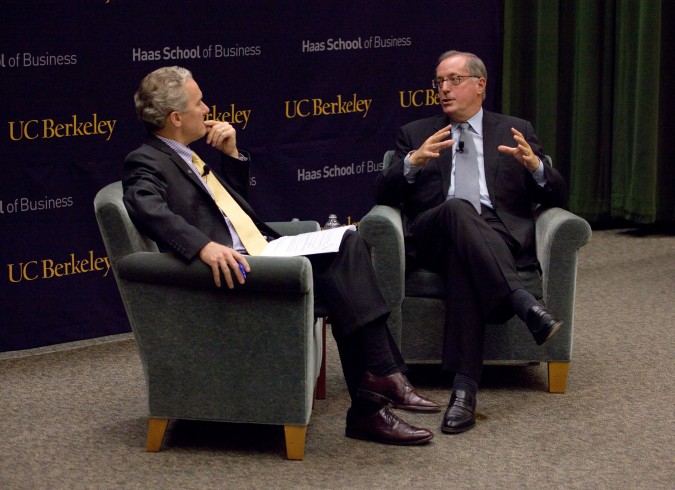
Haas School of Business Dean Rich Lyons and Intel CEO Paul Otellini, October 3, 2012 at University of California Berkeley. Photo by Kevin Warnock.
I like Intel. Their venture capital division Intel Capital was very nice to my company Silveroffice, Inc. by making it an Intel Capital Portfolio Company. Intel Capital invites me as their guest to Intel’s annual Intel Developer Forum, at which I get a new Intel Developer Forum branded laptop bag or backpack, which I use every time I leave my home with my Intel powered laptop. I hope to be appointed a judge for the Intel Global Challenge, a role I would be great at since I was a judge for the Berkeley Startup Competition for eight years through 2011. My application is pending, so please wish me luck! I love judging startup competitions, and so far I have judged four different competitions at University of California Berkeley.
I took all the photographs in this post. I used a Canon 5D Mark II camera with a Canon 80-200mm f:2.8 L zoom lens. Click on the images twice in delayed succession to see the images at full size. I uploaded the images at their full 21 megapixel resolution, at a JPG quality of 12. The light level was comparatively low, so I shot at ISO 2,500, without flash.
Thank you to Meg Fellner of the Dean’s Office for getting me a ticket to this sold out event.
AT&T CEO Randall Stephenson is interviewed September 6, 2012 by Rich Lyons, the Dean of the Haas School of Business at University of California Berkeley

Rich Lyons, Dean of the Haas School of Business at UC Berkeley interviews Randall Stephenson, the CEO and Chair off ATT, September 6, 2012. Photograph by Kevin Warnock.
On Thursday, September 6, 2012, I attended the Dean’s Speaker Series at the Haas School of Business at the University of California at Berkeley, in Berkeley, California USA.
This was the first Dean’s Speaker Series I have attended.
I have been aware of this series for years, but I assumed attendance was restricted to friends of the Dean, Rich Lyons, because of the name of the event.
I’ve met and spoken with the Dean about ten times over the years, I estimate, including when he was the Acting Dean when Dean Tom Campbell took a leave of absence to help then Governor Arnold Schwarzenegger manage the finances of the State of California.

Rich Lyons, Dean of the Haas School of Business at University of California Berkeley, asks Randall Stephenson a question, September 6, 2012. Photograph by Kevin Warnock.
A couple of weeks ago I was looking over the Haas website and marveled at the outstanding list of upcoming individuals the Dean will be interviewing on stage. There in front of me were the magic words — the events are open to members of the Haas ‘community.’ I was pretty sure I qualified, since I am a sponsor of one of the school’s premier events, the Berkeley Startup Competition, and have been every year since 2000. I inquired and I got a seat — I was and am thrilled.
The Dean’s guest for this event was Randall Stephenson, the Chief Executive Officer of AT&T, the largest telecommunications company in the United States.
I am an AT&T customer, both for my home’s broadband Internet connection and for my wireless Apple iPhone 3GS, which I bought soon after launch. I no longer have a wired phone. I like AT&T’s service — I get great reception and few dropped calls.
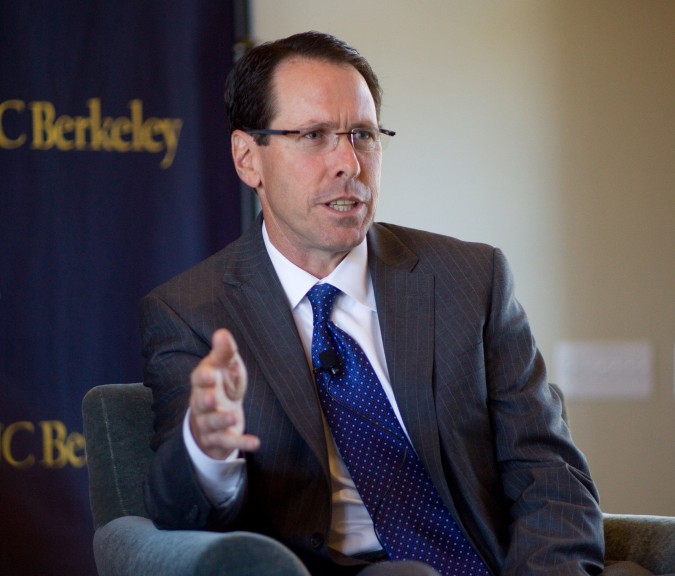
Randall Stephenson, Chair and CEO of AT&T, photographed by Kevin Warnock on September 6, 2012 at UC Berkeley
My regard for AT&T went up after listening to Stephenson speak for an hour. Stephenson was Chief Financial Officer and Chief Operating Officer prior to becoming Chair and CEO, among many roles.
He started at a job he called a ‘tape monkey’ at Southwest Bell Telephone in 1982 loading 19 inch diameter magnetic tapes of billing data onto tape drives. He did this work 12 hours a day — reading a video screen for instruction on which tape to load, finding the tape in storage, loading the tape and then pressing ‘Run.’
I did this same job, though not full time and not for 12 hours a day, when I worked at Cooley LLP. Thankfully I only had to do this role about two weeks a year, when the regular tape technician, Bill Calhoun, went on vacation.
Stephenson said he figured a way to rework his tape loading job to make it much more efficient and enjoyable, though he didn’t tell us the details of what he changed.

Rich Lyons, Dean of the Haas School of Business at University of California Berkeley, listens to Randall Stephenson answer a question, September 6, 2012. Photograph by Kevin Warnock.
During his introductory remarks, Rich Lyons said Stephenson worked in Mexico City as SBC’s Director of Finance.
At some point, Stephenson worked in Mexico for Carlos Slim, the iconic leader of Telmex. Stephenson did not explain how he came to work for Carlos Slim, who presumably was not an SBC employee at any point in his life.
Stephenson said Carlos Slim is ‘the most inherently brilliant individual that I’ve ever worked with.’
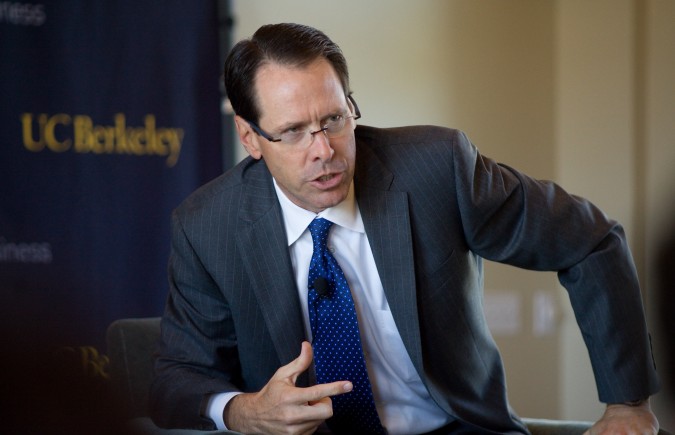
Randall Stephenson, CEO and Chair of AT&T, speaks at University of California at Berkeley, September 6, 2012. Photograph by Kevin Warnock.
Stephenson was in Mexico working for Slim in 1994 when there was an economic crisis that began December 19, 1994, when the Mexican government lifted all restraints on the Mexican Peso and let its value float. The Mexican currency lost 40% of its value in one day, Stephenson recalled.
Slim had 20,000 wireless subscribers in 1994, and thanks in part to the aggressive investments Slim made in the aftermath of the economic crisis of 1994, TelMex now has over 200 million wireless subscribers and Slim has made himself reportedly the wealthiest man in the world.
Stephenson took his job as CEO in June 2007 when ATT was a $100B annual revenue company with 300,000 employees, the same month that Apple launched its first iPhone. Stephenson invested heavily when the 2008 financial crisis came.
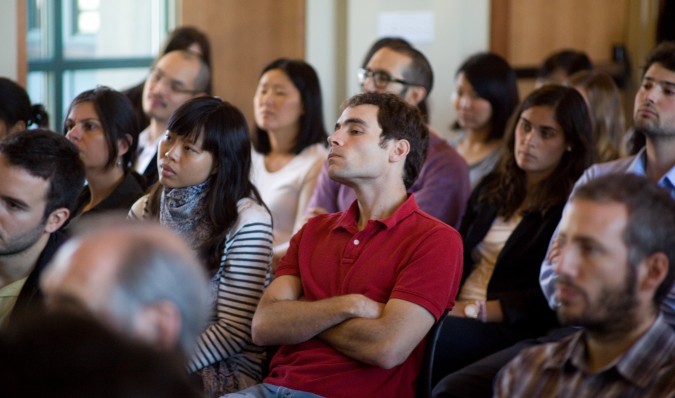
University of California Berkeley students listen to AT&T CEO and Chair Randall Stephenson speak, September 6, 2012
Stephenson said that 170,000 of AT&T’s employees actively participate in its TIP — The Innovation Pipeline — system conceived by the company’s CTO, a guy so tough to hire that it took ten years for Stephenson to do so. This system allows employees to propose ideas for the company to work on developing. People vote on the ideas and the best ones that float to the top are funded and pursued. In response to a question from a student in the audience, Stephenson said that apart from advertising the program to employees the company does little to promote participation. He said participation is quite good.
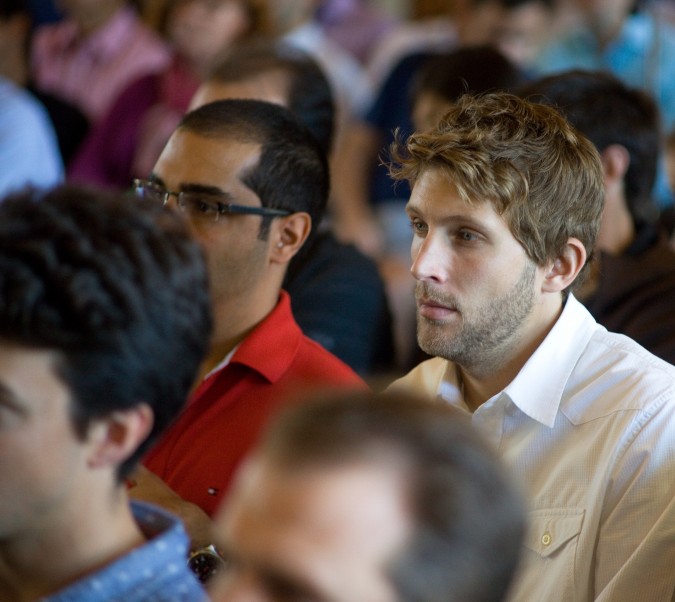
University of California Berkeley students listen to AT&T CEO and Chair Randall Stephenson speak, September 6, 2012
Stephenson and and his public relations person Larry (last name not mentioned) said they were so excited about a couple of their ‘tattooed up’ technologists in their Palo Alto, California research lab named the ‘Foundry’ that they put photographs of them in AT&T’s Annual Report. Stephenson divulged that competitors now are ‘coming after’ these programmers trying to hire them away from AT&T.

University of California Berkeley student asks AT&T CEO Randall Stephenson a question about AT&T's TIP suggestion system, September 6, 2012. Photograph by Kevin Warnock.
A student from the audience asked Stephenson to discuss wireless handset subsidies. Stephenson answered at length and concluded that the current system in the United States is overwhelmingly what customers want. He said AT&T performed studies where customers were asked if they would like to finance a phone via a separate finance contract, in exchange for markedly lower rates for service. Stephenson said customers did not like this proposal.
I think the survey respondents that answered this way are short sighted.
The way things operate in the United States, where one can buy a USD $700 iPhone for $200 because of the carrier subsidies, there is a perverse incentive to upgrade your phone exactly every two years. That is because contracts generally run for two years. If you keep a phone for three years, that final year you are paying much more than is warranted for service.
People should be encouraged to save money, not spend, so I admire the relatively new system reported by Stephenson to be the norm in Europe — phones are not subsidized and rates for service are [I hope] commensurately lower. Stephenson said phone sales dropped dramatically when this policy was implemented, but I say that is just what the world needs. People keep a home phone for decades. People keep televisions, stereos and other household appliances for years. Stephenson told me one-on-one after the event that fully 90% of his company’s customers upgrade their wireless phone every 14 months. Since contracts are two years long, 90% of its customers are paying early termination fees, which decline over time. That is a waste of the world’s resources, even in this day of a vibrant resale market for used mobile phones. I’m pretty sure a lot of people just throw their old mobile phones in a drawer, to benefit nobody. I understand mobile phones improve rapidly, and I do plan to get the latest iPhone when it’s available, having skipped the iPhone 4 and iPhone 4s. I just don’t approve of upgrading exceptionally frequently, which I consider 14 months to be.
I encourage AT&T and all carriers to offer unbundled rates for mobile service, as an option.
Rich Lyons is a good interviewer. The setting was photogenic — two handsome cushioned arm chairs on an elevated stage, with a small end table between the chairs. Lyons and Stephenson wore wireless lapel microphones. There was a backdrop behind the men that repeated the logos for UC Berkeley and the Haas School of Business, so the logos made it into every photograph of the people on stage. As a photographer, I applaud the Dean for creating such an inviting, warm and photogenic environment for his interviews. I look forward with enthusiasm to the next Dean’s Speaker Series interview, which I hope to be able to attend.
Former Haas Dean Dr. Laura D’Andrea Tyson is on the Board of Directors of AT&T, and presumably she helped Lyons recruit Stephenson to visit the Haas School. Tyson was Dean when I was a finalist in the Berkeley Business Plan Competition in 1999 with my company Hotpaper.
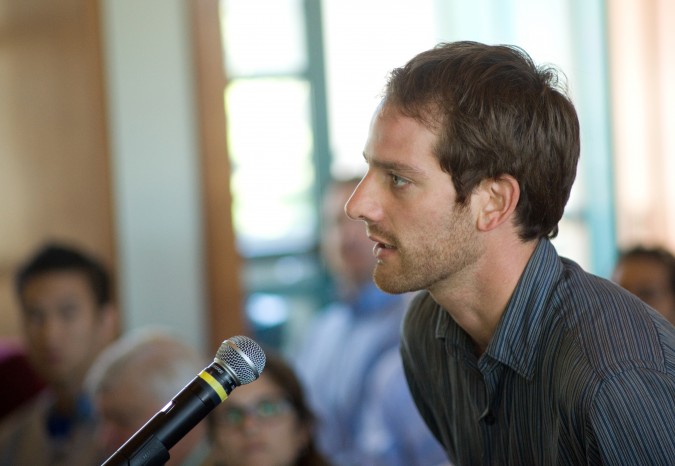
Student asks AT&T CEO and Chair Randall Stephenson a question about mobile handset subsidies, September 6, 2012, at University of California Berkeley
I took the photographs that accompany this blog post.
I used a Canon 5D Mark II camera with the following lenses: Canon 135mm soft-focus lens set to sharp, Canon 16-35mm L zoom lens. I upload pictures to this blog at maximum camera resolution at maximum image quality. Click on the photographs twice in delayed succession to see the full size images. If you would like to use these pictures, please send me a message. If the purpose is reasonable, I will allow usage. I enjoy having my pictures displayed elsewhere. I pursue photography only as a hobby, not as a profession.

At the end of his interview, Rich Lyons stands with ATT CEO and Chair Randall Stephenson at the Haas School of Business, September 6, 2012. Photograph by Kevin Warnock.
Finally, I have some advice for Berkeley students reading this post — introduce yourself to the speaker.
I don’t recall seeing any students introduce themselves to Stephenson. I did see a professor and a president of a good sized company say hello, but that’s it. Stephenson spent several minutes talking with me because there was nobody waiting after me to speak with him. The room had rapidly cleared out. The interview was during the lunch hour, so perhaps the students had to be in class immediately after. It’s rare for so prominent a CEO to speak to such a small group — there were about 140 students in the room by my quick count. I’m sure Stephenson won’t be back this academic year. Make a point of meeting all such prominent speakers. In my mind, Stephenson should have been surrounded by dozens of students trying to shake his hand. Stephenson didn’t appear to be in a rush to depart, and I left before he did.
Berkeley Entrepreneurs Forum, 2012-13 Angel & Venture Capital Financing Overview – August 30, 2012

The Berkeley Entrepreneurs Forum, August 30, 2012, held at Stanley Hall, room 105, because Anderson Auditorium was booked
On August 30, 2012 I attended the 2012-13 Angel & Venture Capital Financing Overview at The Berkeley Entrepreneurs Forum.
The August 30th Forum was the first of this academic year. The Berkeley Entrepreneurs Forum is a production of The Lester Center for Entrepreneurship & Innovation at the Haas School of Business at the University of California Berkeley.
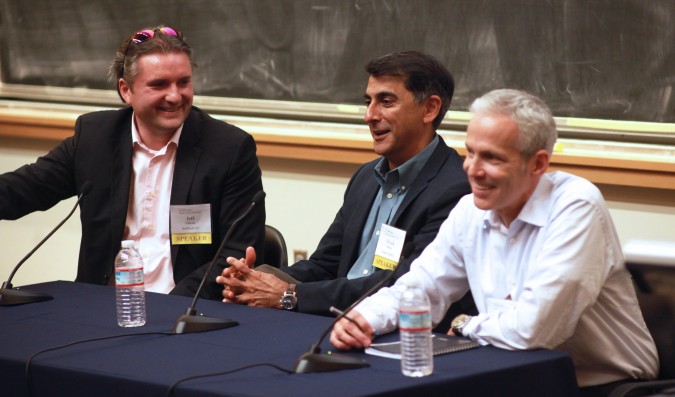
Panelists Jeff Clavier, Vivek Mehra and Jim Barnett at Berkeley Entrepreneurs Forum, August 30, 2012. Photo by Kevin Warnock.
The first Forum of the year for years now starts with Steve Bengston’s presentation of the Shaking the Money Tree report. I suspect Bengston has made this presentation hundreds of times, as he gives it not just at the Forum, but at many venues. In fact, I suspect it’s Bengston’s signature talk.
You can watch the full video of the Forum here to see what happened. I am a photographer, not a videographer. This is not the official video, which The Lester Center will publish in its entirety some weeks from now, I believe. I suggest you watch that version, because it will have professional sound from a mixing board, the slides will likely be full screen so you can read them, and the camera used is far better than the still camera I used that happens to also shoot video. I did not upload this video at full quality, since such video takes far longer to compress for Internet display.
There were some good lines from the speakers. I’ve transcribed my favorites here:
Steve Bengston:
“It [venture capital] finally got big in the mid to late 90s and now we worry when the venture business goes from $30B to $20B, but it never got above $20B until 1998 so the scale of the venture business is just much bigger than it’s ever been.”
“What about Series A, ‘didn’t that collapse?’ It is down certainly from the peak but you can see whatever that is there are $200M to $400M of series A deals each quarter just in Silicon Valley and that represents about 50 to about a 100 Series A deals in Silicon Valley each quarter.”
“The good news is there is a lot of money for your deal if you meet the certain metrics for an investor.”
“If you’re going to raise money which is still hard to do, you’re going to raise around $3M. That’s a typical deal. In this era, that buys you a lot more months of burn than it would have say ten years ago.”
“You have 300 to 400 M & A exits in the US a year in the US, much higher than the old days.”
“The top five or so [venture] firms are raising 80% of the money.”
“It begs the question ‘How many VCs do you need to find the 30 good companies every year?’ Right now the answer is about 3,000. For many people that seems high.”
“China has been the number one economy 15 of the last 18 centuries. So, just because they have had a couple of bad centuries you don’t want to count them out. They are used to being on top.”
Jeff Clavier:
“The challenge at the early stage is that even great founders can come up with really stupid ideas.”
“Do it because you are passionate about it, not because it’s cool.”
“I passed on airbnb that some showed me when it was called air bed and breakfast and I said ‘air bed and breakfast… are you f—ing kidding me?'”
Jim Barnett:
“One of the danger signs that all the partners look for is what we call ‘complexifiers’ — people that take what is otherwise a relatively simple business proposition or business idea and figure out how to make it complex.”
“The one thing I would say to those thinking about starting a company or planning to start a company is just go do it. Your idea really doesn’t need to be that great. It really doesn’t. If you’re great, it will get funded.”
“I want to dispell a myth that you learn more from your mistakes than you do from your successes. I think that is just a bunch of crap. I really do. I think you learn from watching success — pattern matching, whether it’s in sports whether it’s in business or anything else so for those of you that are in the audience that are MBAs or that are undergrads that are thinking about what do if they’re not going to start a company I would say ‘go work for a successful company and watch.’ You’ll learn a lot more than doing three failed startups.”
Vivek Mehra:
“I hate doing deals over the weekend. I have never done one and I hope I never have to do one. It’s just impossible to get to know the entrepreneur.”
“When there are very asymmetric equity assignments amongst the team you know what they really think about each other.”
Here is my succinct summary of this Entrepreneurs Forum:
- The venture industry is in trouble, but there is still plenty of money around.
- Lots of angel investors are making what will prove to be poor investments so this increases the chances that you can raise money even if you or your idea are not that good.
- There is a lot to be gained by just starting a company, so if you are passionate about doing so, then go for it. You won’t ruin your chances for future success by failing a few times.
- However, if you’re not going to start a company, you should work for a clearly successful company so you can pay attention and learn from the success of others.
- Surround yourself with high quality people.
- Don’t make things more complicated than they need to be.
- Have your role worked out with your founders before you pitch to investors. Lopsided equity divisions speak loudly to investors what you think of your co-founders.
- Increase your chances of getting funded by persistently pursuing entrepreneurship over years, so investors may gauge your actions over your words.
- Work hard and recognize that a lot of success may be attributed to your ability to forge healthy and respectful long term relationships with people in the community.

Panelist Jeff Clavier answers questions at the Berkeley Entrepreneurs Forum, August 30, 2012. Photo by Kevin Warnock.
From the Berkeley Entrepreneurs Forum website, here are the introductions for the moderator and speakers — I added the hyperlinks to make it easier for you to learn more about the panelists and their many interests:
Samuel B. Angus
Partner
Fenwick & West LLP
Samuel B. Angus is a partner in the Corporate and Venture Capital Group of Fenwick & West LLP, a law firm specializing in technology and life sciences matters. Mr. Angus is resident in the San Francisco office and his practice concentrates on advising start-up/venture-backed companies, venture capital and debt financings, mergers and acquisitions, intellectual property licensing, joint ventures and general corporate matters. Mr. Angus represents a broad range of companies from privately held start-up companies to publicly traded corporations, including Airbnb, Github, Marin Software and oDesk. His practice also includes advising entrepreneurs and investors.
Jim Barnett
Partner
Shasta Ventures
Jim Barnett is a Partner at Shasta Ventures and has been a highly successful serial CEO and entrepreneur. Jim is currently chairman and co-founder of Turn, chairman of Extole and Sojern, and a board member of Needle and RelayRides. From 2004 until 2009, Jim was CEO, chairman and co-founder of Turn, the leading platform for managing data driven digital advertising. Before that he was president of Overture Search, a division of Overture Services, Inc. Jim joined Overture via its acquisition of AltaVista Company, where he was president and CEO. In this role, he led the company’s successful turnaround and sale to Overture.
Jim was also president of Ancestry.com (MyFamily.com) and president and CEO of ThirdAge Media, which was acquired by Ancestry.com. Prior to that, Jim was president and CEO of Infogrammes North America, a leading global publisher of video games and entertainment software. He was also chairman, president and CEO of Accolade Inc, Infogrammes’ predecessor company, and prior to that was chief operating officer of an “Inc. 100 Fastest Growing Private Companies.”
Jim has served on the boards of many private and public companies including SideStep, Inc. where he was chairman and Petco where he was also an early investor. Jim earned a bachelor’s degree, MBA and J.D. from Stanford University.
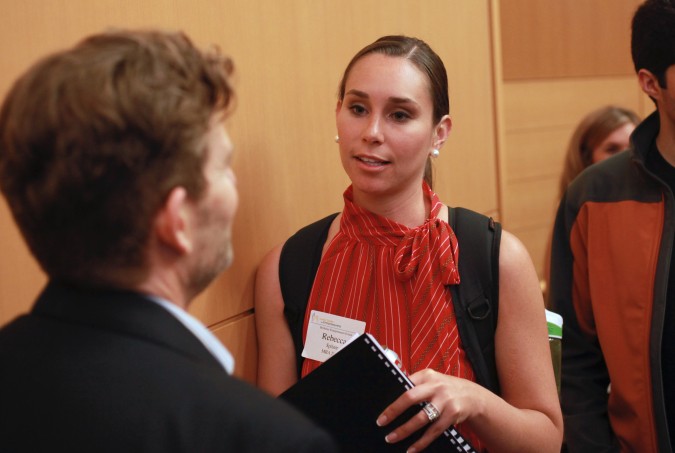
Moderator Sam Angus listens to student Rebecca Spitzer pitch her startup at the Berkeley Entrepreneurs Forum, August 30, 2012
Steve Bengston
PricewaterhouseCoopers
Steve Bengston heads the Emerging Company Services (ECS) group at PricewaterhouseCoopers. ECS acts as “mentor capitalists” for young, high potential companies.
Before joining PwC, Steve had 20 years of experience in a variety of marketing, business development and general management roles at several high tech companies in the Bay Area. Most recently, he was Pres/CEO of ynot.com [Note: not the website now online at that URL], a leading international emarketing and greeting card company. Previously, he was VP Marketing & Business Development at Worldview Systems, an Internet travel pioneer. At Worldview, Steve helped launch and market Travelocity with Sabre Interactive.
Steve has a BA in Economics and MBA from Stanford University. He works closely or sits on the Advisory Board at Churchill Club, SVASE, Life Science Angels, Bay Bio, and the Stanford/MIT Venture Lab, has taught classes on startups at UC Berkeley, San Jose State, Santa Clara Law School, Hastings Law School, and Stanford, and is active in a variety of other organizations in the Bay Area targeting entrepreneurs and investors. He is a frequent moderator/panelist at both university and industry sponsored events.
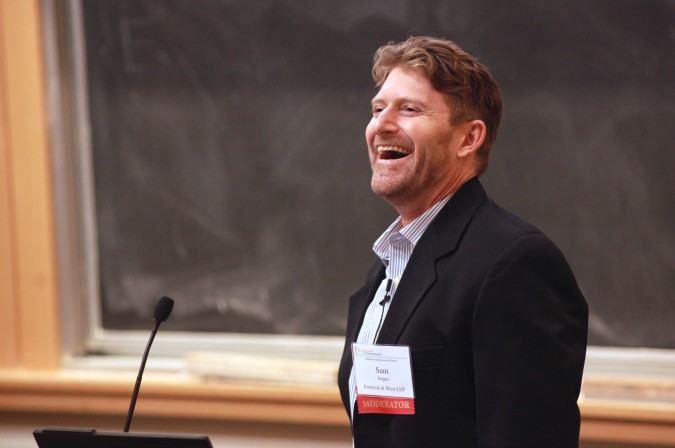
Sam Angus, a partner at law firm Fenwick & West LLP, moderates a panel at the Berkeley Entrepreneurs Forum, August 30, 2012
Jeff Clavier
Founder and Managing Partner
SoftTech VC
Based in Palo Alto, California, Jean-Francois “Jeff” Clavier is the Founder and Managing Partner of SoftTech VC, one of the most active seed stage investors in Web 2.0 startups. Since 2004, Jeff has invested 125 consumer internet startups (Fund I, Fund II, Fund III) in areas like social media, monetization, search, gaming or B2B/B2C web services. These investments are typically located in Silicon Valley, New-York and Boulder. With over 20 years of operational, entrepreneurial and venture capital experience, Jeff is able to add relevant perspective and value to his companies as they grow from inception to maturity, and hopefully, success.
Jeff was recognized as one of the 13 “Web 2.0 King Makers” by (late) Business 2.0. BusinessWeek named him one of “The 25 Most Influential People on the Web” in 2008, and one of the “Top 25 Angels in Tech” in 2010. He was also nominated in the “Best Angel” category at the Crunchies in 2009 and 2010. He is often noted for his investments in categories such as “passion-centric communities” or online gaming, or for having sold a number of his Web 2.0 startups to the likes of Yahoo, AOL, Intuit or more recently PayPal, Twitter and Groupon.
Some of Jeff’s representative investments include Mint (Intuit), Brightroll, Truveo (AOL), Userplane (AOL), Rapleaf, Ustream, Milo (eBay), Blekko, Eventbrite, Tapulous (Disney), DNANexus, FanBridge, BillFloat, Fab, Gigwalk, Byliner and Wildfire.
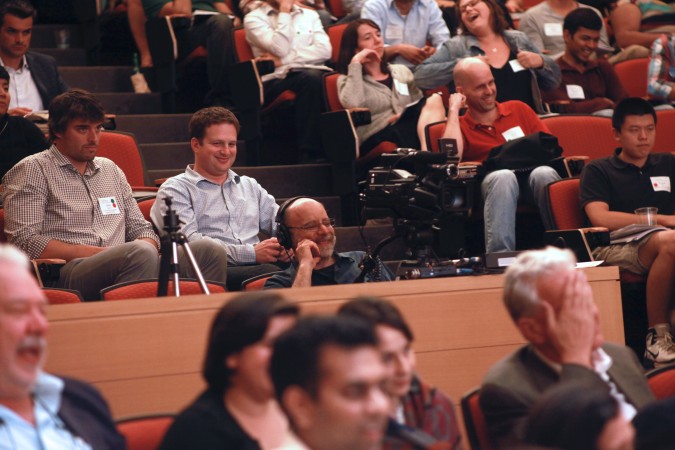
Stuart Sweetow, owner of Audio Video Consultants, capturing video at the Berkeley Entrepreneurs Forum, August 30, 2012
Vivek Mehra
August Capital
Vivek joined August Capital in 2003. He invests broadly in IT infrastructure and areas of interest include data center technologies, systems management, security, storage, and cloud computing systems and software. Prior to joining August Capital, Vivek co-founded Cobalt Networks in 1996. As CTO & VP of Product Development, Vivek built the first successful server appliance and grew Cobalt into a worldwide leader in the category, culminating in a successful IPO and acquisition by Sun Microsystems for $2B. At Sun, Vivek served as the Vice President and General Manager of the Cobalt Business Unit and a member of Sun’s Technical Architecture Council. Prior to founding Cobalt, Vivek held a number of technical and management positions at Apple, SGI, and Digital Equipment Corporation and successfully developed numerous products including Internet enabled set-top boxes, PDAs, RISC workstations, and high performance graphics subsystems.
Vivek received a BS in Electronics from Punjab University, India, and an MS in Computer Engineering from Iowa State University.
To my knowledge, I have been attending The Berkeley Entrepreneurs Forum for longer than anyone else besides Jerry Engel, who founded The Lester Center in 1991 and was its Executive Director for nearly two decades.
I have some suggestions to improve the The Entrepreneurs Forum, which I will describe here. I am posting these suggestions publicly because they are likely applicable to numerous programs across the globe, and I’d like to see these ideas adopted widely if people think they are worthwhile.
1. Dispense with the table panelists sit at. The table doesn’t look good on camera or video, and over time the majority audience for the Forum should be watching online, since the rooms frequently sell out already. Panelists should sit on arm chairs or couches, like they do at most tech conferences that I attend. The moderator should sit with the panelists and not be off to the side standing at a podium. All the people on stage should be outfitted with wireless lapel microphones. I would like the Forum to appear more conversational in style. The table separates the speakers from the audience, where arm chairs suggest a residence for a more intimate vibe.
Here’s an example of a more visually appealing way to run a panel. Steve Bengston is the moderator for this panel at The Churchill Club, where he is a member of its Board of Directors and its past Chair.
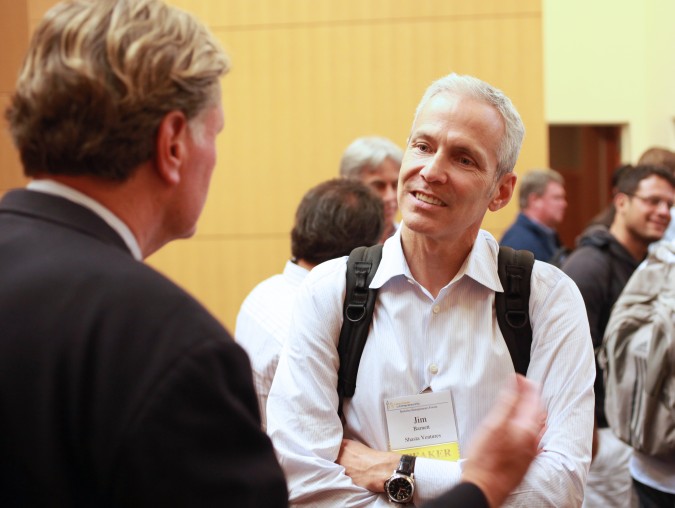
Jeff Burton, the brand new Executive Director of the UC Berkeley Skydeck, talks with Jim Barnett of Shasta Ventures, August 30, 2012
2. Commercial bottled water should be forbidden on stage, even if the speakers bring it with them. Nearly all the conferences I attend serve water from pitchers into real glasses. Bottled water is an evil product, and it looks bad in photographs and video to see those bottles. Image is important, and promoting bottled water by showing it on stage should stop.
3. Commercial bottled water should not be a beverage choice during the networking hour. Tap water should be offered, and it should not require a drink ticket.
4. When it comes time for audience questions, invite the questioner to sit on stage in an arm chair or on the couch while they ask the question and while they are receiving the answer. This will give the questioner time on video, and will permit them to look the speakers in the eye. This will be a treat for the audience members, because they’ll feel they get to ‘meet’ the panelists for 60 or 120 seconds. Questioners can line up to get their turn on stage. Questioners should be encouraged to state their first and last name, so they can be identified online.
5. Although I appreciate that it’s a lot of work, the Forums should be transcribed, and the transcribed text should be posted online. This is a certain way to get more traffic to The Lester Center website, and it’s likely to increase the interest in the Forum from attendees that can’t attend in person.
6. All Forums should be archived online, including Forums from ten and twenty years ago. Forums should never expire and be removed.
7. The ‘numbers’ should be videotaped and included in the online video. The numbers are often the most interesting part of the evening. The contact information for the number presenters should be posted online, with permission of course, and there should be a hyperlink to the project the person is working on.
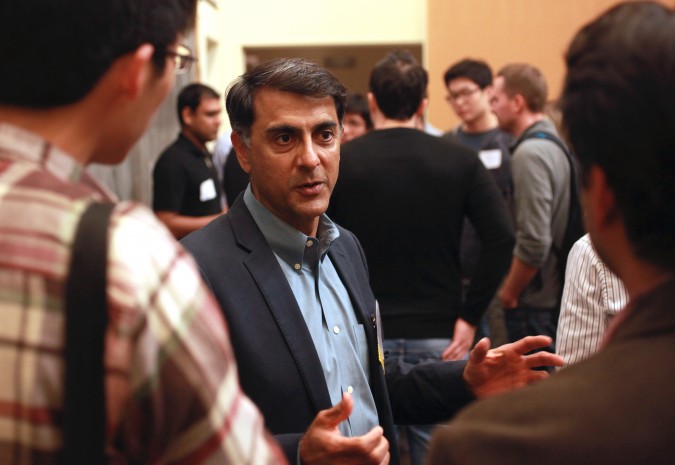
Vivek Mehra, a partner at August Capital, answers questions posed by attendees at the Berkeley Entrepreneurs Forum, August 30, 2012
8. The photographs taken by Bruce Cook, the official photographer, should be publicly posted to Facebook, and should be tagged. Once the identities of the people pictured are known via the tagging, the captions for the official Lester Center website should be updated to identify everyone whose name is known. If required, change the terms of the tickets purchased to give UC Berkeley the right to identify the people by name. Offer an ‘opt out’ list during checkin. Having the names with the pictures will increase traffic to The Lester Center website, since people will search for those names for decades to come. Invite people to tag the pictures in the emails The Lester Center sends out and via Facebook status updates.
9. A vast collection of at least 5,000 of Bruce Cook’s unpublished photographs of the Forum from the last twenty years should be published to Facebook and the Web, and they should be tagged and captioned. This was entirely my idea — Cook did not hint that I propose such an idea. The majority of the pictures published should be of the networking hour, to get as many people from the audiences over the years tagged as possible.
10. The Forum should be oversold, like airplane seats. This August 30th Forum was ‘sold out’ but there were unfilled seats in the auditorium, which takes away from the excitement of a sold out show. If too many people show up, they can watch on video monitors in the Bank of America Forum, and as compensation for not getting a seat, their entrance fee can be 100% refunded. I predict the revenue over time from overbooking will more than make up for the refunds that need to be given. Attendees should be told when they buy their tickets they risk being bumped, and encouraged to arrive early to be sure they get a seat.
11. The reminder to ‘Like’ The Lester Center on Facebook should be repeated on a poster displayed during the Forum. The Forum’s Twitter handle should also be on this poster.
12. Attendees should be given a perk if they follow the Forum on social networks, such as a second drink ticket on their next visit to the Forum, to encourage getting as many followers as possible. Currently attendees may eat unlimited quantities of food at the Forum, but are permitted only one drink, either with alcohol or without.
13. Attendees should be invited to blog and post about the Forums, and The Lester Center site should find and link to the best examples of such efforts, to encourage people to write about the Forum.
I am one of the only bloggers writing about the Forum, but there should be at least several.
14. I love the luxurious food served during the networking hour, but it sure seems like it must cost a fortune. I think it would be more than fine to switch to less fancy food. There is precedent for this. Last year at the Founder School Demo Day what appeared to be inexpensive sandwiches were served, but the event was superb and not diminished by the more everyday food. I suspect the food budget for the Forum could be cut by two thirds without getting more than a handful of complaints. The Forum is still too expensive at USD $25 a ticket, and I bet it loses money even at that price. When I started attending in my mid twenties, the cost was prohibitive. It was only due to my getting free tickets from my employer at the time, Cooley, that I attended regularly. The goal should be to get lots of currently poor entrepreneurs in the making to attend, including but not limited to Berkeley students.
I suggest the price should be no more than $10. To get the price that low, I suggest alcohol should cost extra.
That is all my suggestions for now. The Forum is already a success, or I would not have attended for twenty years. I am trying to make the Forum better.
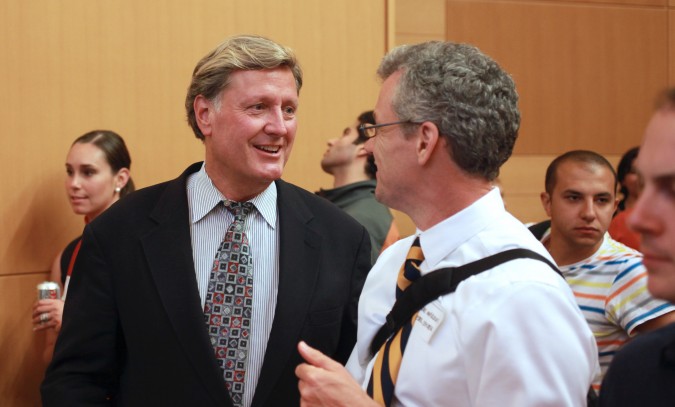
Jeff-Burton, left, the brand new Executive Director of the UC Berkeley Skydeck talks with Andre Marquis, Executive Director of The Lester Center for Entrepreneurship & Innovation, August 30, 2012. Photo by Kevin Warnock.
I upload pictures to this blog at the maximum resolution my camera produces — 21 megapixels. Click on them twice in delayed succession to see them at full size. I shot these pictures at ISO 4,000 due to the low lighting levels.
Click here to see all the posts I have written about the Berkeley Entrepreneurs Forum.
The law firm Fenwick & West LLP where Sam Angus is a partner produced and gave away a great 80 page booklet at the Forum. Retired Fenwick attorney Jacqueline Daunt wrote a fantastic introduction to startups that includes a capitalization table for a hypothetical company from pre-funding stage through a public stock offering. Thank you Fenwick! If I can post this booklet, please let me know and I’ll update this post with a link to a PDF scan of the booklet.
Finally, as an end note, I met Steve Bengston in 1999 during the first dot com boom, when he agreed to help me with Hotpaper, my startup at the time. It turned out I didn’t call on him much, since I lined up financing almost too easily, but I will never forget pitching him at his PriceWaterhouseCoopers office in San Jose, California USA, and him telling me at that meeting that he would help me. Bengston is well known, and I was thrilled to have his support, especially back then when I didn’t know many people or know much of anything.
Annual Andrew Fluegelman Awards Gala Honoring Outstanding Students, Student-Athletes & Foster Parents, May 18, 2012
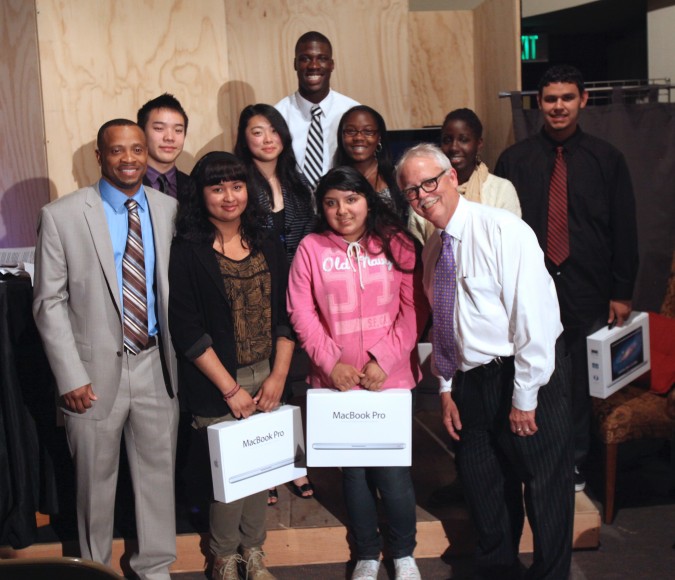
Winners of 2012 Andrew Fluegelman Foundation Fellowship Awards showing off their new Apple MacBook Pro laptop computers, May 18, 2012. Bruce Bouligny on left and David Bunnell in white shirt.
On Friday, May 18, 2012, the day of the Facebook Initial Public Offering of stock, I attended the annual Andrew Fluegelman Foundation Fellowship Awards Gala, held at the Linen Life Gallery at 770 East 14th Street, San Leandro, California USA. Here is the Facebook page for the Andrew Fluegelman Foundation. Bruce Bouligny is the Director of the Fluegelman Foundation.
I learned of this event the morning of the event, thanks to a Facebook status update from Harry McCracken, Editor-at-large at Time Magazine. McCracken encouraged his Facebook subscribers, of which I am one, to attend this event. McCracken also linked to a piece he wrote for Time entitled Remembering Andrew Fluegelman, a Quiet Giant of the PC Revolution that introduced me to Andrew Fluegelman, a man I had not previously heard of. Once I read McCracken’s piece on Fluegelman, I got a ticket for the Awards Gala and attended as a blogger. Amazingly, the tickets were free, although they did ask for a modest donation at the door, which I happily made.
Andrew Fluegelman disappeared in 1986, and it’s assumed he committed suicide by jumping from the Golden Gate Bridge. He was 42, and his body was never found.
I had only been at the Linen Life Gallery for mere minutes when my friend Stuart Sweetow came over to say hello. I recognized him but couldn’t place him, as I only see Sweetow at the Berkeley Entrepreneurs Forum at The Lester Center for Entrepreneurship and Innovation at the Haas School of Business at the University of California at Berkeley. He’s the videographer for the forums, and has been for some 15 years. I have had the privilege of appearing in one of Sweetow’s videos that he created for the Forum.
Sweetow absolutely made my evening.
How so? It turns out that Sweetow runs a business called Audio Visual Consultants. He’s been in business since 1983 — impressive. In 1986 he was hired by PC World, which Fluegelman co-founded with David Bunnell, to produce a video tribute to Andrew Fluegelman.
A few weeks ago, Sweetow was moving his company’s office and studio to new space and he stumbled upon the ancient video cassette he had produced decades earlier. He decided to call David Bunnell, the co-founder of the Andrew Fluegelman Foundation (and PC World Magazine), to ask if he wanted the tape. Bunnell was probably stunned to get Sweetow’s call. The copy PC World received decades ago had been lost. It was thought that it would never resurface. Thanks to Sweetow, the Foundation and presumably PC World has the video again, and it’s been posted to YouTube so a wider audience can view it.
What a heartwarming story. Here’s Sweetow’s video:
I asked Sweetow if I could blog about this story, and he said that I may.
Sweetow then pointed out that David Bunnell was standing near us. Sweetow offered to introduce me, and I accepted.
David Bunnell co-founded PC World Magazine with Andrew Fluegelman. I used to read PC World frequently. Before the Internet, such magazines were required reading for those interested in technology. You read such magazines the way we read websites like TechCrunch and Engadget today. I got to meet a publishing legend Friday night.
Happily, PC World is still in business, with a vibrant online presence in addition to the physical editions of the magazine.
I asked David Bunnell if I could photograph him, and not only did he agree, but volunteered to step outside into the still bright daylight so I could get a well lit portrait of him. Had he not volunteered, I would have directed him outside, as the light there was perfect. The pictures of Bunnell are at the bottom of this post.
I used my Canon 5D Mark II for these photographs, and I uploaded them at full 21 megapixel resolution. Click on the pictures to see them at full size.
Here is what David Bunnell wrote for the official paper program distributed at the event:
“Andrew Fluegelman (1942-1985)
During his brief life, Andrew made major contributions to the booming computer revolution. In addition to co-founding PC World and Macworld magazines, he wrote PC-Talk, the software program that for the first time made it possible for personal computers to exchange data over a phone line.
Believing that PC-Talk should be available to as many people as possible, Andrew came up with the novel idea of simply giving it away and asking people to send in a donation if they liked the program.
Andrew called this method of distributing software, “freeware.” Thousands of other programmers started making their software available this way, which helped the PC industry grow even faster.
Underlying Andrew’s work was his profound belief that personal computers have the power to transform anyone’s life. Whatever a person’s background and circumstance, if they had a computer their lives could be dramatically changed for the better.
With the help of some of Andrew’s other friends, I established the Andrew Fluegelman Foundation to keep his memory alive and to realize his vision that computers can make a dramatic difference.
Working with other nonprofit organizations, we identify outstanding high school seniors who have overcome the challenges of growing up in poor neighborhoods and who have been accepted into university, college or other advanced educational program. They also must demonstrate a desire to “give back” to their communities.
In Andrew’s name, we give these students a Macintosh laptop computer, printer and training in the use of Google applications, courtesy of Google.
So far, all the students who have won Fluegelman Fellowships have gone on to be successful in college. They arepot to us that owning their own Macintosh computers has been a huge part of that success.
I truly believe Andrew would have loved this program, and that his spirit is with us tonight.
–David Bunnell”
Fluegelman in 1982 created PC-Talk, the first dialup communications program for IBM Personal Computers and their clones. Back then, computers were connected via standard wired telephones directly to each other, not by going through central servers run by companies like AOL, Compuserve or Prodigy. Fluegelman distributed PC-Talk at no charge, and encouraged people to copy it and give it to friends. He made money by asking but not requiring that people mail him money via postal mail. He suggested donations of USD $25 and later more. That was a fair amount of money back then. I suspect it still works today, at least on Windows XP.
Fluegelman was the first Editor-in-Chief of PC World magazine. He interviewed Bill Gates in 1984, as shown in this picture from the Fluegelman Foundation’s Facebook page:

Andrew Fluegelman, on the far right, interviewing Bill Gates, standing, in 1984. Photographer unknown.
The Fluegelman Foundation honors Andrew Fluegelman’s memory by awarding Apple MacBook Pro computers to seven deserving high school seniors each year. Fluegelman believed that a computer could change a person’s life, so he would have approved of the work this foundation is doing.
This year Apple MacBooks were awarded to:
- Daniel Rodriguez – Castlemont High School
- Teresa Unique Cole – MetWest High School
- Andranee Nabors – Berkeley High School
- Cara He – Skyline High School
- Rocio Montes – Skyline High School
- Brian Lien – Skyline High School
David Bunnell and Bruce Bouligny took turns reading portions of the winning essays these winners submitted to compete for the laptops. The students were not given a chance at the microphone to say ‘thank you.’ I suspect this was the first time these students had been on stage outside of school. In future years, I suggest the organizers allow each student 60 seconds at the microphone to say thank you. They should be told of this opportunity in advance so they can prepare and practice their remarks. They will likely be nervous, but it should be a condition of winning that they say something. It will be a valuable learning experience to speak before strangers, and it’s one they won’t likely ever forget. The audience I am sure would welcome hearing from the students.
I tried hard to get permission to photograph the winners individually like I was able to photograph David Bunnell and Larry Magid, below. But I didn’t ask soon enough and the time simply ran out. I would have loved the chance to spend two minutes with each student properly photographing them. If I attend next year, I will prepare in advance with the organizers so that I can do this.
The Fluegelman Foundation also gives awards to an outstanding foster parent each year. I did not learn how this award is connected to Fluegelman, and there may be no overt connection. Whether there is or not isn’t important. The evening was an inspiring delight, and I am so glad that I attended.
Two foster parents spoke.
The first foster parent to speak was Tracy Beckham, who has 12 children. Eleven she and her husband adopted after doctors told her they would not be able to conceive and carry to term a biological child. We learned that their youngest child, the girl in the white dress below, is their biological child, and she was conceived naturally with no assistance from the fertility industry. Beckham told us how doctors at first thought she was sick, but eventually concluded she was pregnant. What a happy surprise.

Tracy Beckham with her family plus a few others, May 18, 2012 at Andrew Fluegelman Fellowship Awards Gala. Photo by Kevin Warnock.
Beckham’s 6’6″ son Dorial Green-Beckham, the tallest in the two shots immediately above and below, is already famous, with his own entry in WikiPediA, I learned. The pictures I took of him are likely to get this blog some significant traffic. Thank you Dorial and thank you to his mother Tracy, who gave me permission.
Dorial is a famous high school football player. According to The Columbian Missourian newspaper, Dorian was the most recruited high school football player in the United States in 2012. Here’s a long piece that details how intense this process was.
Dorial signed with the Missouri Mizzou Tigers, after a courtship that lasted years. I had no idea before today that even happened. I don’t follow football, and I only occasionally watch the Super Bowl.
I had never heard of Dorial before this event. I am glad that I met him, and he was gracious and patient as I set up the pictures you see here. I gave him posing directions just like I give the female models I photograph. I wonder what he thought of me given that he’s probably been photographed by hundreds and hundreds of photographers to date.
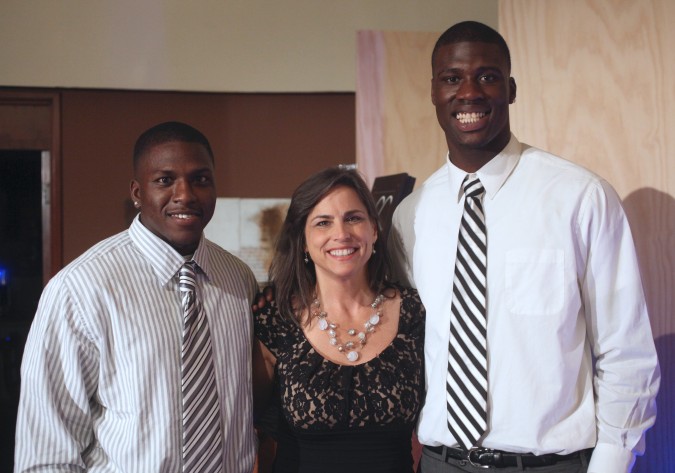
Tracy Beckham with 2 of her 12 children including Dorial Green-Beckham on the right. May 18, 2012 in San Leandro, California. Photo by Kevin Warnock.
Have a look at this YouTube video that shows Dorial breaking the United States national receiving record for high school football.
Here’s a clip of Dorial catching a 79 yard pass with one hand during the 2012 Army All American Game. Looks impressive to me:
Dorial Green-Beckham was awarded the first National Fellowship awarded by the Fluegelman Foundation, and Dorian was given an opportunity to speak to the audience, which he accepted.
The second foster parent to speak was Athaline Burns, shown in the photograph below holding her award plaque for East Bay Foster Parent of the Year.
Burns told the crowd she provided care to about 100 foster children that lived in her home over the years. This is an astonishing and important contribution to society. Burns kept her remarks short, so I don’t have any stories to relate about her remarkable life. I didn’t have the opportunity to talk with her after the event, which I regret. I would like to interview her for this blog at some point, and meet her family to hear about their experiences first hand. I have at times considered becoming a foster parent, so I have more than a casual interest in this subject.
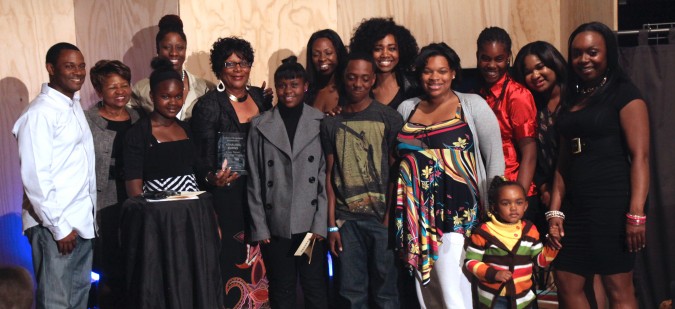
Athaline Burns, holding award plaque, shown with her family. Burns is East Bay Foster Parent of the Year. May 18, 2012 in San Leandro, California. Photograph by Kevin Warnock.
Here is the portrait that I took of David Bunnell and Larry Magid together:
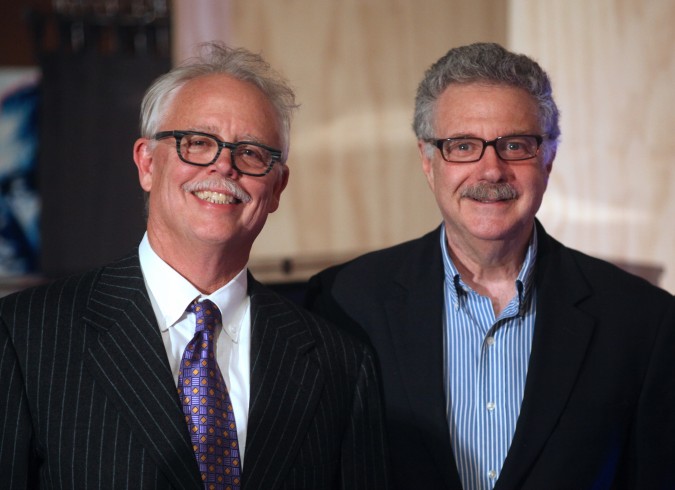
David Bunnell and Larry Magid, May 18, 2012 at Andrew Fluegelman Foundation Fellowship Awards Gala in San Leandro, California. Photo by Kevin Warnock.
Bunnell and Magid provided commentary at the start of the event about the storied life of Andrew Fluegelman. I got the distinct impression that both Bunnell and Magid are elder statesmen in the technology industry, so I am so grateful that I got to photograph them together and separately, and that the results were so pleasing. Magid asked if he could use the results, and I happily told him that he may. Of course, Bunnell may as well, as well as all the others that I photographed. I am very flattered when I encounter my photographs around the web and on other peoples’ Facebook pages. Twenty four of my Facebook friends are also friends with Magid.
Larry Magid is Co-Director of ConnectSafely, a non-profit. Magid provided Gala attendees with free copies of the book A Parent’s Guide to Facebook (also published in Arabic). I have a copy, and from reading part of it I can say it’s well written and likely to be very valuable to parents. I’ve never seen such a lushly produced guide to safely using potentially a potentially dangerous site like Facebook. I plan to read the entire book. Here’s an abstract of what ConnectSafely is about, from the group’s website:
“ConnectSafely is for parents, teens, educators, advocates – everyone engaged in and interested in the impact of the social Web. The user-driven, all-media, multi-platform, fixed and mobile social Web is a big part of young people’s lives, and this is the central space – linked to from social networks across the Web – for learning about safe, civil use of Web 2.0 together. Our forum is also designed to give teens and parents a voice in the public discussion about youth online safety begun back in the ’90s. ConnectSafely also has all kinds of social-media safety tips for teens and parents, the latest youth-tech news, and many other resources.
ConnectSafely.org is a project of Tech Parenting Group, a 501(c)3 nonprofit organization based in Palo Alto, Calif., and Salt Lake City, Utah. The forum is co-directed by Larry Magid of SafeKids.com and Anne Collier of NetFamilyNews.org, co-authors of MySpace Unraveled: What It Is and How to Use It Safely. (Peachpit Press, Berkeley, Calif., July 2006).”
Larry Magid is also the on-air technology analyst for CBS. Magid has over 62,000 subscribers on Facebook.
Here is the portrait that I took of David Bunnell:
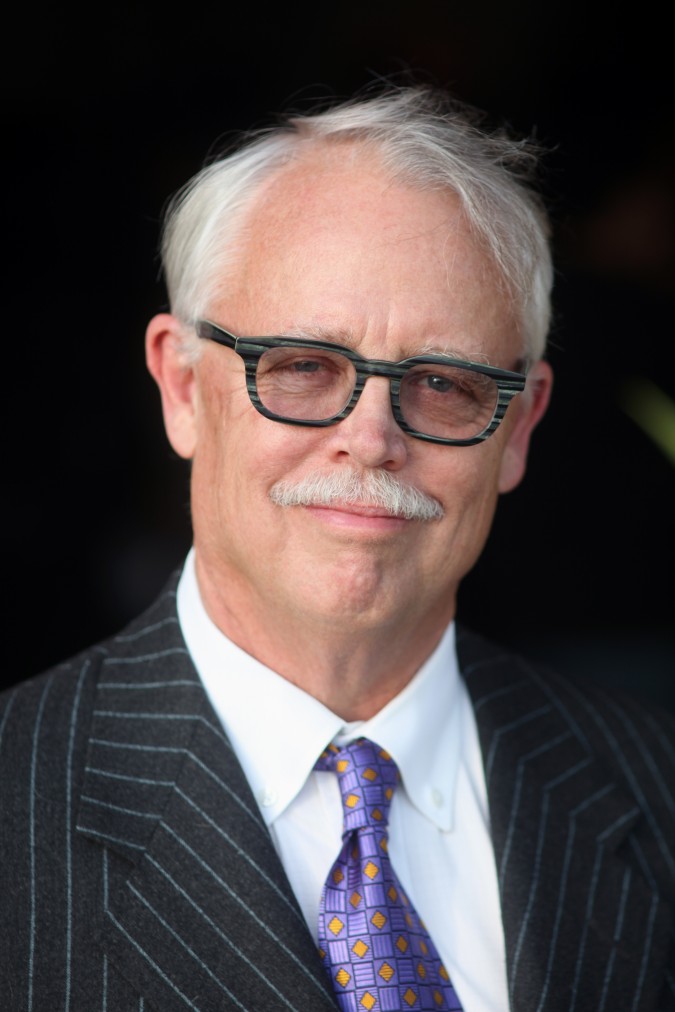
David Bunnell, co-founder of Andrew Fluegelman Foundation, May 18, 2012. Photographed by Kevin Warnock.
Here is the portrait that I took of Larry Magid:

Larry Magid, on-air technology analyst for CBS, photographed May 18, 2012 at the Andrew Fluegelman Foundation Fellowship Awards Gala. Photo by Kevin Warnock.
Here is a photograph of the reception prior to the awards ceremony. The food and drink were outstanding, thanks to B Restaurant and Bar, Trader Joe’s, Markham Vineyards, Carl Talaue Catering, RSVP Catering and T-Rex BBQ.
The Skyline Jazz Band, made of up musicians from Skyline High School, played during the reception. The band’s director is Vincent Tolliver. The musicians are:
- Olivia Ports – Drums
- Ella Pearson – Piano
- David McMillan – Guitar
- Zach Seidl – Bass
- Jeff Seidl – Trombone
- Jeramy Kaetzel – Trumpet
- Andrew Wong-Rolle – Alto Saxiphone
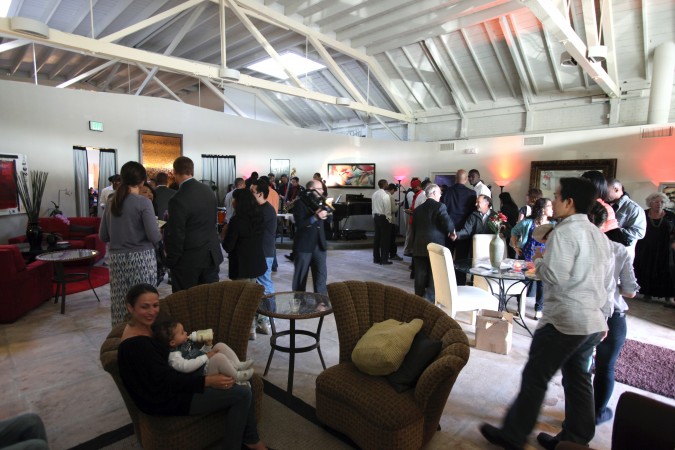
Reception at 2012 Andrew Fluegelman Foundation Awards Gala in San Leandro, California, May 18, 2012. That's Stuart Sweetow in the center holding the video camera.
Charleston Pierce was the Master of Ceremony. I found him vibrant, charismatic and engaging. He said he’s a graduate of San Francisco School of the Arts, or SOTA. This school is located in the same building where I went to high school. That school, J. Eugene McAteer High School, was dissolved in 2002 due to its being atrocious, which I can personally confirm.
SOTA seems to be churning out winners, like Devon Ivie, Havel Weidner and Cristina Rey, all of whom I met in February, 2012 at the San Francisco Mock Trials citywide finals. They were on the student team representing SOTA, which this year competed with Lowell High School, generally thought to be the best public high school in San Francisco. SOTA lost to Lowell this year, but has won over Lowell multiple times in past years. The students I met in February are very polished and impressive, and I predict they will go far in life, unlike most of my McAteer classmates, I am sad to report.
I got to shake Pierce’s hand, but sadly didn’t get to interview him. He’s in the entertainment industry, and I bet he’s somebody my readers would love to learn more about. If he’s reading this, I invite him to contact me to schedule an interview.
Congratulations to all the winners at the 2012 Andrew Fluegelman Foundation Fellowship Awards. To the student winners, I say study hard in college, drink alcohol very moderately or not at all, decline all illegal substances and activities, keep in touch with your professors long after you graduate, and start building and nurturing your personal brand right now, by blogging and Tweeting thoughtfully, articulately and responsibly.
When you graduate, future employers will then have four years (decline the five year program!!!) of your posts to read to get a sense of who you are and why they should hire you. You’ll be far ahead of most of your peers, even your peers that might have better academic credentials than you have earned. In life it’s not just grades, but your character, passion and drive that will advance you past your peers. You can start today with WordPress and your shiny new Macbooks. Good luck, and drop me a line once a year to let me know how your MacBook enhanced lives are going. I will write about you here if you take me up on this.
College will be over in two snaps of your fingers, so relish it, embrace it and blog about it! Have fun.
———-
May 21, 2012 – I added a photo credit to the caption under photograph of Stuart Sweetow, which was taken by Rufus Diamant.
2012 Berkeley Startup Competition Finals at University of California Berkeley
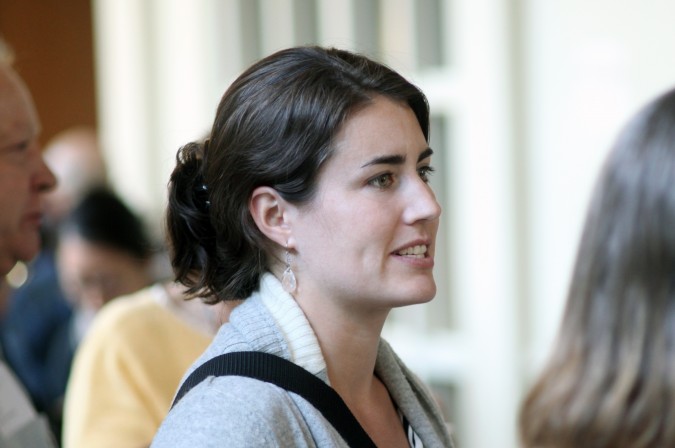
Kate Garrett, co-founder of Calcula Technologies, Grand Prize winner of the 2012 Berkeley Startup Competition, April 26, 2012
On Thursday, April 26, 2012, I attended the Berkeley Startup Competition Final Awards Ceremony at the Anderson Auditorium on the campus of The Haas School of Business at the University of California at Berkeley. Here is the PDF format file of the 2012 Berkeley Startup Competition Final Awards Ceremony program booklet that was handed out at the final awards ceremony.
There are many people mentioned in the booklet, like the Co-Chairs for the 2012 competition, Nick Nascioli, Adam Sterling and Tom VanLangen, as well as Lester Center Executive Director Andre Marquis and Haas School of Business Dean Richard Lyons.

Grand Prize winner Calcula Technologies at the Berkeley Startup Competition, April 26, 2012. Left to right: Nick Mascioli (co-chair of the Competition), Adam Sterling (co-chair of the Competition), Kate Garrett, Dan Azagury, David Gal, Buzz Bonneau, Tom VanLangen (co-chair of the Competition)
I most recently wrote about the announcement of the finalists for this competition, which happened two days earlier, on April 24, 2012.
Calcula Technologies won the Grand Prize and the Life Sciences Track for their clever system that vacuums kidney stones out of a patient’s urethra in just ten seconds. According to the team’s presentation, doctors today let stones pass from the body naturally and often quite painfully unless they are larger than 10mm in diameter. Patients today are often in such agony that they visit the emergency room, which racks up hundreds of millions of dollars in charges per year. For the sub 10mm stones, doctors just write prescriptions for narcotic pain killers and send the patients home with the stones still on their excruciating slow path out.
In the future, when and if Calcula gets their system approved by regulators, patients could have a catheter inserted into their urethra and the stone could be sucked out in seconds, presumably at great relief to the patient. This work could be done at the office of a urologist, without surgery, and the Calcula team said there is already a prized and lucrative reimbursement code in existence in the insurance industry, so if they build this system, they will be able to get paid and make a profit. I can understand why Calcula Technologies won the grand prize. Kidney stones are no fun, I’ve heard, and this system seems very appealing. The team showed a video of a fake kidney stone being sucked out of a pig’s urethra in just 10 seconds. It was very impressive and very memorable.
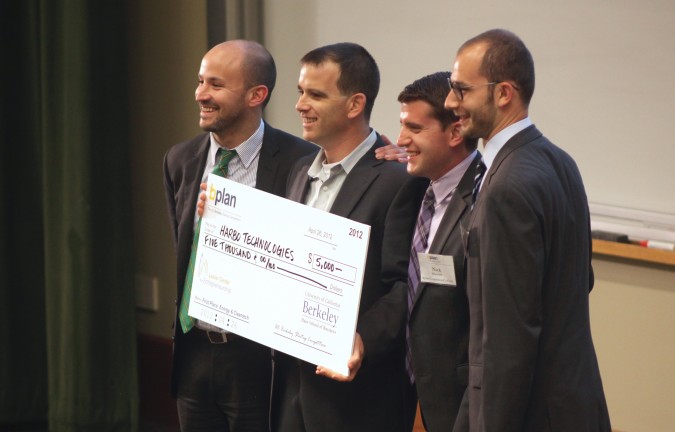
First Place Energy and Cleantech winner Harbo Technologies at the Berkeley Startup Competition, April 26, 2012
Kloudless, Inc. won first place in the Information Technologies and Web Track. I am going to be interviewing Kloudless, so I’ll save my remarks for another blog post.
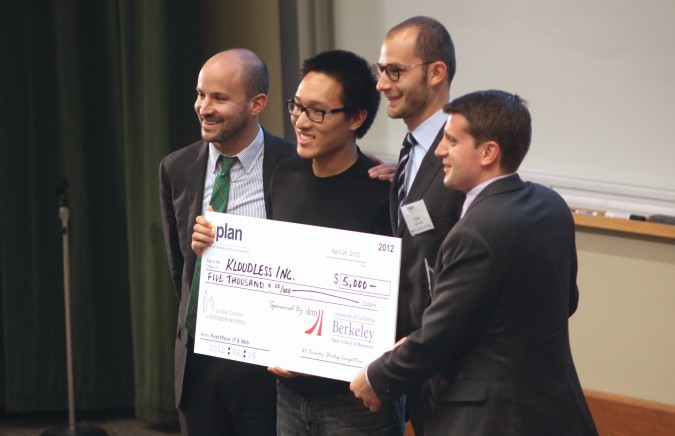
First place IT and Web Track winner Kloudless, Inc. at the Berkeley Startup Competition, April 26, 2012
Like Calcula, Back to the Roots (2935 Adeline Street, Oakland California 94608 USA) won two awards. First, they won the Products and Services Track, and then, thanks to real time votes from the audience and viewers of a live stream on the Internet, they won the Peoples’ Choice Award.
I have written about Back to the Roots twice before.
I have one of their products at my house right now. It works.
Back to the Roots collects used coffee grounds from coffee houses like Peet’s Coffee and mixes it with a ‘secret sauce.’ The combination is boxed up and sold at over 1,000 stores in the United States, including at Home Depot and Whole Foods Market. A consumer buys the cardboard box and partly opens it, exposing the insides. The consumer then mists the contents of the box with water using an included spray bottle. After ten days of twice daily misting, the consumer harvests a bountiful crop of oyster mushrooms that have grown directly out of the side of the box. Once one side has been used up, the consumer opens the other side to repeat the growing cycle for a second harvest.
That story has been told thousands of times, including on the CBS Evening News, an influential national newscast in the United States.
During their public presentation, the Back to the Roots team disclosed future plans that I find fascinating. Since this event was public and was streamed live to the Internet, I feel that it’s OK to write about what I learned, as there were no statements that anything said was to be considered secret.
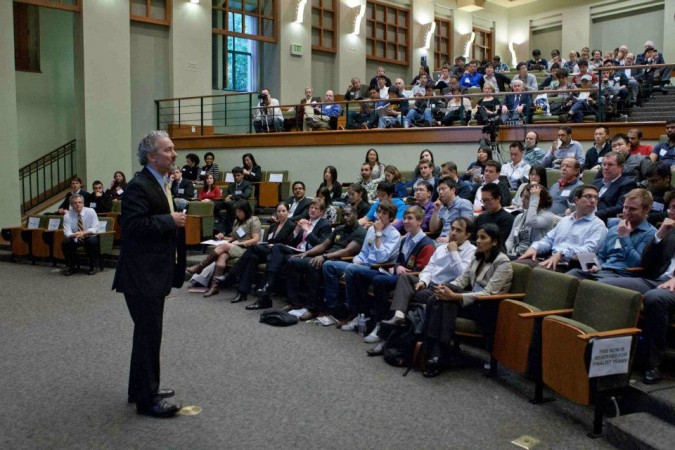
Haas School of Business Dean Richard Lyons speaks at the Berkeley Startup Competition Finals, April 26, 2012. Photograph by Bruce Cook.
The box contents will soon include vegetable plant seeds, and the rest of the box and liner will be biodegradable. Currently, the box is lined with what looks like conventional plastic. My box is from November, 2011, so things today may be different. In the future, or perhaps even already, the box will be lined with either nothing or something else that’s biodegradable. Perhaps what looks like conventional plastic to me is really biodegradable plastic, like some plastic trash bags are made of.

Venture capitalist Michael Berolzheimer, of Bee Partners, attends the Berkeley Startup Competition, April 26, 2012. Berolzheimer also leads the Haas Founders group that I am a member of.
Why do this?
Once the box is biodegradable and contains vegetable seeds, that means that after the two mushroom harvests the box can be planted in dirt for ’round three’ of production — vegetables. The mushrooms came from the waste stream from coffee houses. The round three vegetable garden will come from the waste stream of the mushroom garden.
This is beautiful.
What’s coming down the road from Back to the Roots?
I am overjoyed to report the answer may be affordable aquaponics kits.
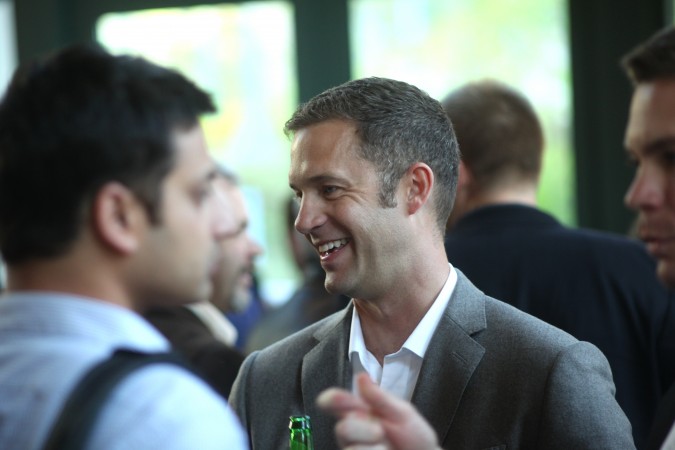
Kevin Esse at networking hour prior to attending Berkeley Startup Competition Finals, April 26, 2012
I have written before about my love for aquaponics.
Aquaponics is food production gardening enhanced by growing edible fish in symbiosis with vegetable plants. Both parts of the system are made more productive by the presence of the other half. Fish poop gets converted by bacteria into rich fertilizer. The fish grow faster because the plants keep the fish tank cleaner. It’s a great growing system that I feel should take over the world on such a scale that every person has their own system at home.
I am too busy in life to advance this dream, but the team at Back to the Roots has time and energy and market traction, so I think they would be ideal to push aquaponics to a large audience. I am so excited about this that I have already offered to tell the company everything I know about aquaponics free of charge to encourage them to get this to market.
I suspect they plan to start with small, under USD $100 demonstration kits. This in my mind is the way to start.
I bought my startup supplies for my aquaponics system from The Aquaponics Source. This online retailer sells complete systems, but the price is too high for people to buy casually, at over USD $1,000. I believe a profitable sub $100 kit could be sold, as what’s required is similar to what’s inside a Mr. Coffee brand coffee maker — two water containers, a pump, a heater and some electronics to coordinate the steps. I can get a nice computerized Mr. Coffee coffee maker for about USD $25 from Amazon, so even in the smaller quantities a demonstration aquaponics system would sell in initially, I think it can be done.
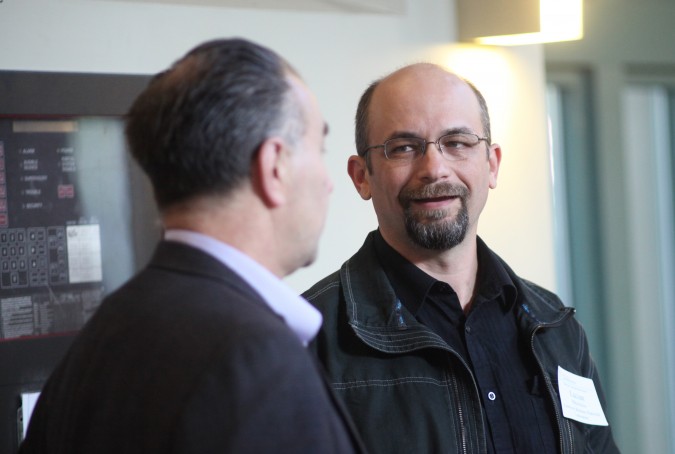
Lucian Mihailescu of Lawrence Berkeley National Laboratory attends the Berkeley Startup Competition, April 26, 2012
I love advising startup companies, and I would particularly like to advise about aquaponics, even though I know relatively little about the subject, since I’ve only built one demonstration system so far. My system was a modest success for I grew the largest and sweetest tomatoes I have ever eaten.
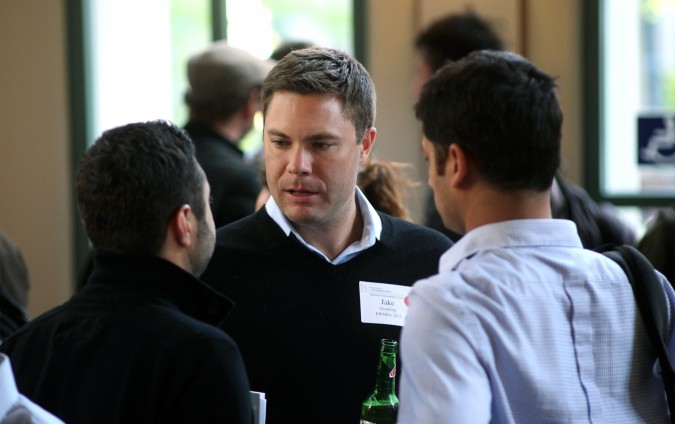
Jake Gentling at the networking hour prior to attending the Berkeley Startup Competition Finals, April 26, 2012
HARBO Technologies won First Place in the Energy and Cleantech track. I introduced myself to co-founder Boaz Ur and mentor John Matthesen after the conclusion of the event. The company is working on something I find impressive and interesting. I have made arrangements to interview the team, so I will hold my remarks until after that interview.
My friends at Modify Industries took home a USD $1,000 prize for coming in second place in the Products and Services Track. This outcome was inevitable, and I predicted it accurately the moment I saw Modify was competing with Back to the Roots. Back to the Roots simply has had much more commercial success so far. While Modify has sold between 10,000 and 100,000 watches to such companies as Google and Hewlett Packard, they haven’t yet cracked the retail store market, and they haven’t been on the evening television news. It’s rare for a company to be so far along like Back to the Roots, but still be eligible to compete in the Berkeley Startup Competition. In all other years where there was a Products and Services Track, Modify probably would have won that track. I pay attention to these things because I was a judge for this competition for the eight years through 2011. This year I mentored the team University Gateway, which did not make it to the finals since Modify and Back to the Roots filled up the Products and Services Track.
Modify gave an impressive and bold presentation, where they outlined a dream for their enterprise far bigger than time pieces. They probably adjusted their pitch to compete with Back to the Roots. But they forgot to show their product in action amid all the grand dream spinning. How so? They forgot to personally show the audience how to change a watch element from one silicone strap to another. This is worth showing at every pitch for it’s compelling and like nothing I’ve seen in the watch business. No tools, no training — 10 seconds and you have an all new look.
Finally, I want to give some space to my friend and fellow photographer Bruce Cook. I’ve known Cook since nearly the inception of The Lester Center for Entrepreneurship & Innovation. He’s a fixture at all sizable Lester Center events. He has his own photography business, Bruce Cook Photography, and is not a University of California employee. I can’t recall there ever being a different photographer for a Lester Center event. The picture above is of Cook standing under the video light in Anderson Auditorium. The picture below is of Cook taking a picture during the networking hour in the Bank of America Forum, the large gathering area just outside of the Anderson Auditorium. Cook took the picture above of Dean Lyons speaking to the audience. Thank you Bruce!
If The Lester Center is reading this, may I suggest that you contact Cook and work out a deal where his vast library of photographs of Lester Center events over the last twenty years can find a permanent home on the Lester Center website and in the University library system. Cook has photographed some of the most important figures of our time, and the tremendous majority, over 99%, of his photographs have not been published. I think these photographs should also be published on Facebook so that it’s easy to crowd source the identification of the people in the pictures, via the Facebook tagging system. Once the faces are tagged, then the captions on the Lester Center website can be updated to reflect the identities of those pictured.
Why do this?
The Lester Center and its events are documenting history. It’s that simple. Bruce Cook has a treasure trove of historic pictures that few have ever seen.
As an added bonus, publishing and captioning Cook’s 100,000+ pictures will boost traffic to The Lester Center’s website, as people search on Google and similar sites for the many luminaries Cook has photographed. The search engine optimization benefits to posting these pictures will probably overshadow every other single project you could undertake.
This is my idea alone.
Cook did not plant this, suggest this or hint at this.
I’ve been thinking about this for years now, and here seems like a fine place to promote the idea.
I believe I have shared this suggestion with Jerry Engel when he was Executive Director of The Lester Center, but that was only in passing at a hectic Berkeley Entrepreneurs Forum, not a written proposal such as this one.
Please consider this official advice, and let me know when I can blog about the happy news. Thank you.
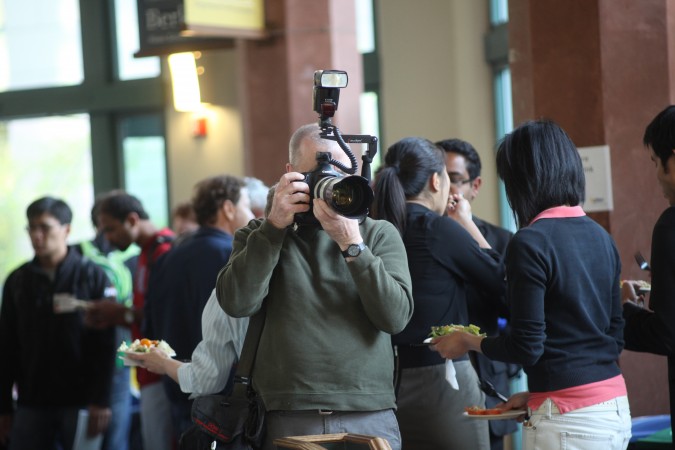
Bruce Cook, the photographer for The Lester Center events, covers the Berkeley Startup Competition, April 26, 2012
I introduced myself to all the finalist teams except AdrenaRX. I believe the members from that team departed before I had a chance to find them.
I offered each of the eight finalist teams except for Modify and Back to the Roots the opportunity to be interviewed by me for a future blog entry. Two of the teams have contacted me to schedule an interview. Four teams have not yet contacted me.
I know the Modify and Back to the Roots founders, so I did not offer to interview them. This was not meant as a snub — I simply forgot to offer in my excitement of congratulating them. Both teams are doing so well they don’t need my blog coverage, but if they would like more in depth stories, I am happy to meet with them. Just send me a message. I am on Facebook and easy to reach. I have turned on the ‘subscribe’ feature, so everyone reading this is invited to subscribe to me on Facebook. You may also sign up with your email address to receive updates to this blog, in the upper right corner of this page.
All the pictures I presented above except for the one by Bruce Cook are also on my Facebook page in this album. If you know these people, particularly the people in the shots with the giant checks, please tag them on Facebook so I can update the captions here with the names. All my pictures on Facebook are public, so if you tag someone there, I consider those names to be public, and on that basis I will update the captions here.
The sponsors for the 2012 Berkeley Startup Competition include:
Gold level:
Claremont Creek Ventures
DCM
UM
Silver level:
Javelin Venture Partners
Lowenstein Sandler
Mintz Levin
Mohr Davidow
Morgan Stanley
Morgenthaler Ventures
Morrison & Foerster LLP
Wilson Sonsini Goodrich & Rosati PC
Individual level:
There were possibly other individual sponsors. No individual level sponsors were listed in official materials this year, a departure from past years.
The Executive Committee for the 2012 Berkeley Startup Competition:
Co-Chairs
Nick Mascioli
Adam Sterling
Tom VanLangen
Judging & Sponsorship
Robbie Allan
Jane Buescher
Vivien Leong
Larry Pier
Marketing & Events
Stephanie Knoch
Krishna Shah
Mentorship & Events
Amara Aigbedion
Hrishikesh Desai
Program Manager
Kirsten Berzon
Berkeley Startup Competition finalists, including Back to the Roots and Modify, are announced
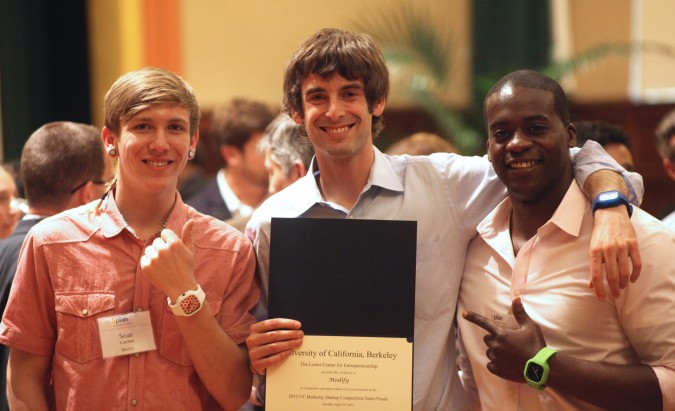 HARBO Technologies
HARBO TechnologiesSean Linehan, Aaron Schwartz and Ayo Oluwole of Modify, April 24, 2012. Modify is a finalist in the 2012 Berkeley Startup Competition.
Last night, on April 24, 2012, I attended a reception at the University of California Berkeley Clark Kerr Campus. The reception was held to announce the finalists for the 2012 Berkeley Startup Competition. This event used to be called the Berkeley Business Plan Competition. I competed in the finals of this competition in its inaugural year, and have sponsored the competition every year since, including in 2012.
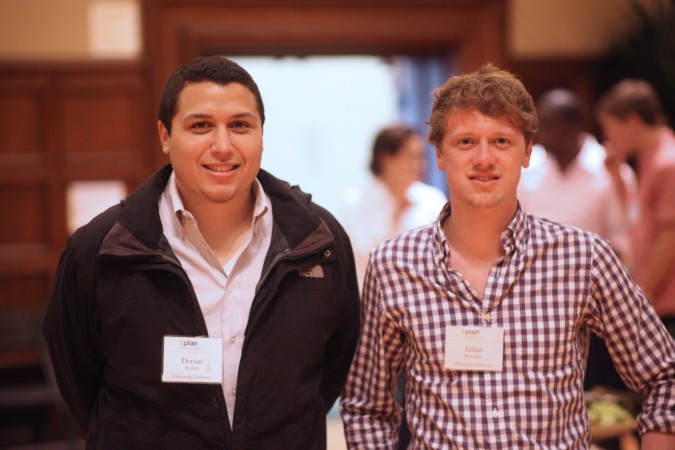
Dorian Walder and Julian Riediger of University Gateway, April 24, 2012. Kevin Warnock mentored this team this year.
This year I was a mentor to semi-finalist team University Gateway, lead by Dorian Walden. I got to know Walden over four meetings, some of them stretching to 3 hours around my dining room table. Sadly, University Gateway did not progress to the finals, but it was easy for Walden to understand why.
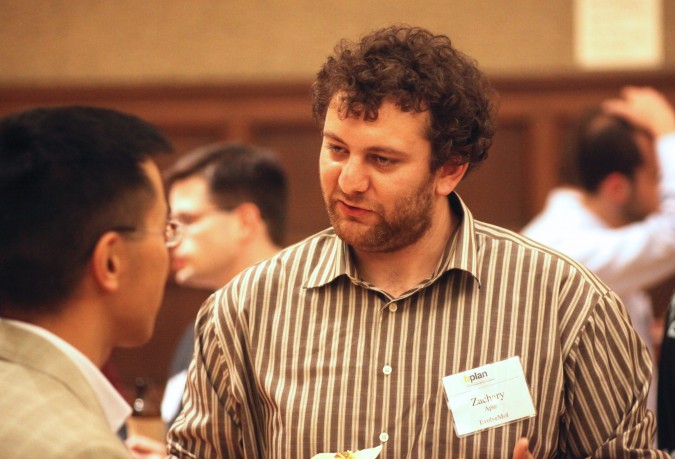
Zachary Apte of EvolveMol, April 24, 2012. Apte is at the Berkeley Startup Competition finalists announcement reception.
Two teams I know personally were in the same judging category as University Gateway — Products and Services. University Gateway is an Internet company, but the track for Internet companies apparently was filled up already. This meant University Gateway was competing with companies that make and sell physical goods.
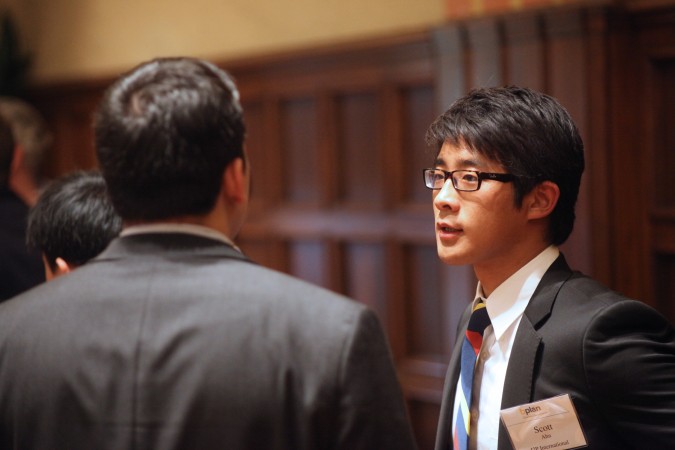
Scott Ahn of J2P International, April 24 2012. Ahn is at the Berkeley Startup Competition finalists announcement reception.
The teams I know that competed in the Products and Services track both were advanced to the finals. I was 99.9% confident that this would be the result, even though I knew nothing about the other competing teams. I was so confident because the teams I know are so strong, and I have been a judge for this competition for the past 8 years or so. I know from experience that teams this strong always make it to the finals.
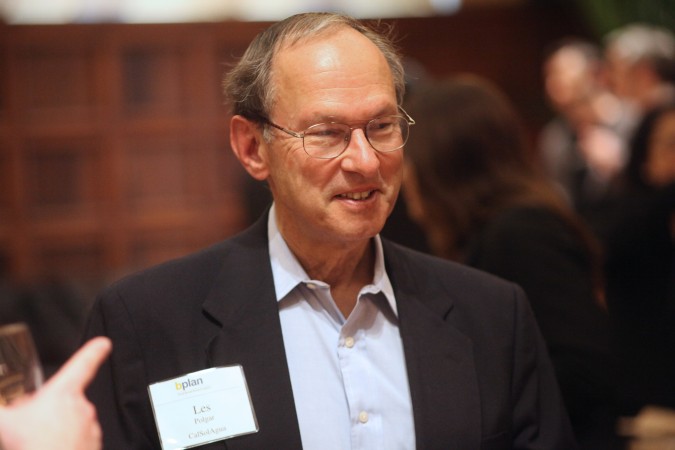
Les Polgar of CalSolAgua, April 24, 2012. Polgar is at the Berkeley Startup Competition finalists announcement reception.
I also know that teams this strong are very rare, so it was unlikely that the Products and Services track had any other teams so strong. I have never gone home from judging thinking that a third team from my judging track should have gone on to the finals.
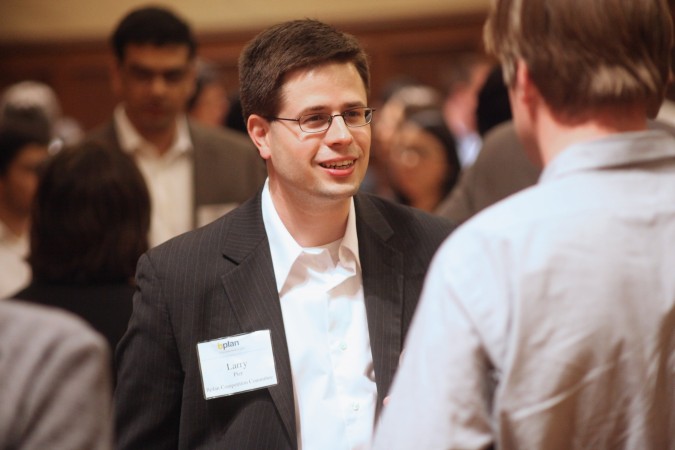
Larry Pier of Berkeley Startup Competition, April 24 2012. Pier is at the Berkeley Startup Competition finalists announcement reception.
University Gateway has a good idea, and I hope that Dorian Walder and Julian Riediger make their venture a success. The company is still in stealth mode, so I won’t tell you what they do yet.
The Products and Services teams that advanced to the finals are Modify and Back to the Roots. Both are unusual companies for this Berkeley competition.
Modify makes wrist watches that you can change easily to suit your tastes. The straps are made from silicone, similar to what silicone bake ware is made from. One can pop the time piece out of the strap/case in just a second, with no tools or special skills required. The straps are available in bright colors, and I describe them as chunky chic. The team from Modify are each wearing a Modfiy watch in the photograph I took at the top of this post. I am friends with Modify founder Aaron Schwartz. We see each other most months at the Haas Founders group I wrote about March 11, 2012.
Schwartz is a likeable and modest guy — only when researching this blog post did I discover he’s been profiled in a blog published by The New York Times newspaper. The New York Times is worth tens of millions of dollars less than photo sharing smart phone application Instagram, but I’d much prefer to be written about in a blog by The New York Times than in a blog by Instagram.
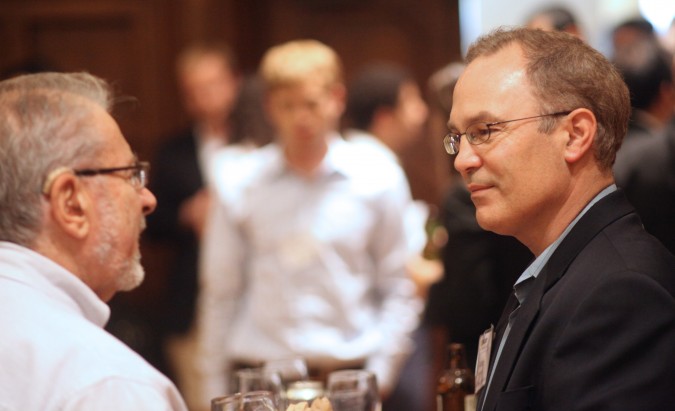
John Steuart of Claremont Creek Ventures, April 24, 2012. Steuart is a judge for the Berkeley Startup Competition.
Back to the Roots makes and sells affordable oyster mushroom growing kits. I’ve written about Back to the Roots when I saw their CEO Nikhil Arora speak on a panel at a Food Startups Meetup run by my friend Matthew Wise, the co-founder of both Founderly and Tableslice. Back to the Roots has 20 full time employees, or so I was told when I interviewed a staff member at their booth at the San Francisco Flower and Garden Show on March 24, 2012.
Back to the Roots has received lots of press coverage, including two minutes and forty seconds on the national CBS Evening News in the United States on March 15, 2012. The newscast says that Back to the Roots sells its products in over 1,000 stores and has 28 employees. Impressive.
Both Modify and Back to the Roots have businesses that are well along. Modify has sold _____ of thousands of watches to companies as well known as _____ and _____. [I’m waiting to hear from Schwartz to fill in the blanks in the last sentence. I know the values, but I want to verify the numbers and names I know are meant to be public information.] Back to the Roots sells its kits at Whole Foods Market and Home Depot. While Modfiy and Back to the Roots are still startups, they are making big strides and are companies to watch.
The reception was well attended and busy. I got to talk with my fellow judges from past years of this competition. I captured video. I took hundreds of pictures. I didn’t eat until the event was technically over. What I didn’t get to do, sadly, was interview the finalist teams that I didn’t know. If they are reading this and would like to be the subject of a future blog post, I invite them to contact me. I’ll meet you for coffee and you can give me your pitch and I’ll write about your venture.
Here is a list of the 2012 finalists for the Berkeley Startup Competition. The descriptive text that follows was provided by the teams themselves.
- Kloudless, Inc.
Kloudless is a free service that helps you manage all the things you put in the cloud. We enable users to search for, access, and manage their information that is spread across the Internet. We’re starting with email attachments, the black hole of cloud services, and will expand to other cloud services in the near future. Our solution addresses an increasingly large problem as more and more information moves into the cloud.
- Traverie
Traverie is an explorer focused startup that leverages the emotional, personal and inherently social aspects of travel discovery to make the process visual, fun and trustworthy. We bring structure to the current ad hoc and offline model of discovering and selecting destinations. We blend user-generated content, professional content and advertising to deliver a compelling user experience. Our founding team comprises a designer, engineer and product manager from MIT, Harvard and Berkeley-Haas, respectively.
- AdrenaRx
AdrenaRx is a biopharmaceutical company focused on the prevention and treatment of heart failure due to toxicity from cancer chemotherapy. Each year, 1.6 million Americans are affected by cancer, and a third of these patients receive chemotherapy that can damage their heart. AdrenaRx has identified a new therapeutic target and a potent, selective drug that can protect the heart from damage by chemotherapy, and reduce a patient’s risk of developing heart failure after surviving cancer.
- Calcula Technologies
Calcula Technologies is developing a novel urological medical device for the removal of kidney stones outside of the operating room. Our patent pending technology will treat 4M patients/year in the US and EU. With clear FDA predicates and existing CPT reimbursement codes Calcula will be a major disruption in the field of Urology.
- Claro Energy
Claro Energy provides solar-powered water pumping solutions to meet irrigation needs of farmers in remote power-deficit agriculture areas in India where costly diesel generated power is the default choice. Claro Energy’s solar-powered pumps have near zero operating costs, are longer lasting and highly reliable when compared to dieselpowered pumps. In combination with sales, marketing and business development competencies, Claro Energy has also developed in-house integration and implementation expertise in remote rural regions of India.
- HARBO Technologies
During the first critical hours, oil-spills spread, split, and create escalating irreversible damage. HARBO develops the only emergency oil-spill containment solution for immediate response. HARBO’s Zero Time to Spill system is at standby position on-board oil-tankers/rigs and other ships and deploys a boom (floating barrier) within minutes to contain spills. HARBO’s advantage: Minimizing environmental damage, avoiding large containment/cleanup expenses, offering superb costefficiency and preventing a PR nightmare. “Containing oil-spills when they’re small, preventing big disasters.”
- Back to the Roots
Back to the Roots, started by two Haas Business School undergrads, promotes sustainability and zero-waste, while reconnecting people to food through its grow-at-home mushroom kit. Our gourmet mushroom kits are made with 100% recycled coffee grounds, and produce 2 pounds of fresh oyster mushrooms in just 10 days! People of all ages can actually grow and eat their own mushrooms all at home, a unique experience in today’s urban lifestyle.
- Modify
Modify is a brand built on freedom of expression. Customizable for individual style, Modify’s interchangeable watches offer dope design for anyday wear. Available in two different sizes and over 250 combinations, Modify is a brand made for anyone—anytime, anyplace. A proponent of exceptional personalized service, we engage organizations and fans to help create (and name!) watches. Modify Watches are available for corporate gifting and licensing.
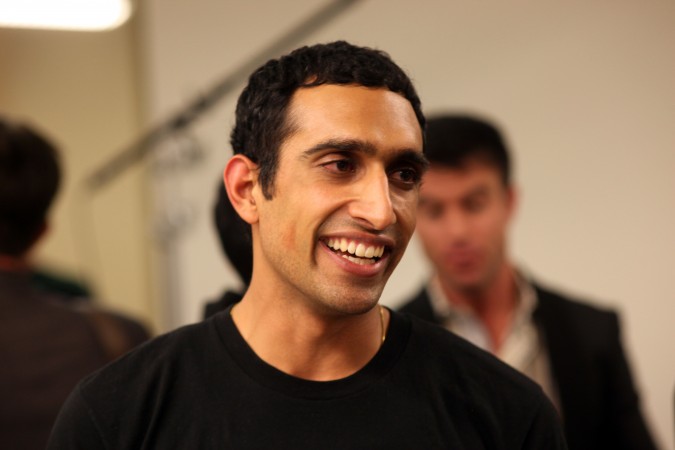
Nikhil Arora, the CEO of Back to the Roots. This was taken by Kevin Warnock on November 16, 2011, not at the Berkeley Startup Competition event.
Here’s the handheld video I captured of the finalist teams learning of their advancement and collecting their certificates documenting their achievements. Andre Marquis, the Executive Director of The Lester Center for Entrepreneurship & Innovation, delivers the opening remarks. John Steuart, Managing Director at Claremont Creek Ventures, comments on the judging process. Steuart’s firm is a financial sponsor of the competition, and Steuart is one of the judges.
—–
Anthony Franco of Better Cater, pictured above, contacted me and asked me to link to his startup’s website. Sorry for the delay in creating the link — I just saw your Facebook message from April 25th a few minutes ago. Kevin — May 3, 2012 @ 12:47am.


